







































































A Day of Appreciation
An









































































An
40
A

Kentucky

Test your knowledge of our beloved Commonwealth. To find out how you fared, see page 6.
1. After the British captured Washington during the War of 1812, they attacked Fort McHenry in Baltimore. How many stars were on the United States flag that flew over the fort during the attack?
A. 13
B. 15
C. 18
2. During the War of 1812, Francis Scott Key, a D.C. attorney, wrote a poem that became the lyrics of the U.S. national anthem after he witnessed the Battle of Baltimore on an American truce ship. How many stripes were on the flag that Key called “The Star-Spangled Banner”?
A. 13
B. 15 C. 18
3. Which president vetoed a proposal to build a road from Lexington to Maysville, claiming that funding such intrastate infrastructure projects with federal money was unconstitutional?
A. John Quincy Adams
B. James K. Polk
C. Andrew Jackson
4. In the U.S. Capitol, each state can place two statues honoring its heroes or statesmen. Henry Clay is represented by one of Kentucky’s statues. Who is immortalized by the other?
A. Daniel Boone
B. Abraham Lincoln
C. Ephraim McDowell
5. When Mary Todd Lincoln was First Lady in the White House, she enjoyed hosting dinners to dignitaries, politicians and influential citizens. How did she fund these events?
A. Tapping into reserves designated for the Union Army
B. Donations from wealthy benefactors
C. Using money for maintaining the White House grounds
6. During the presidential election of 1824, the House of Representatives selected the winner since no candidate had received enough votes in the Electoral College. Who was the designated winner?
A. John Quincy Adams
B. Andrew Jackson
C. Henry Clay
7. Before AMTRAK, the C&O Railroad ran daily passenger service directly from Washington to Louisville. The train was known by what name?
A. The George Washington
B. The Falls City Limited
C. The Blue Grass Express
8. Lake Barkley in western Kentucky is named for Alben W. Barkley of McCracken County. What was the highest federal government position Barkley held while in Washington?
A. Secretary of State
B. Majority Leader of the U.S. Senate
C. Vice President
9. In 1966, the University of Kentucky was runner-up in the NCAA men’s basketball tournament, which was played outside of Washington, D.C., in College Park, Maryland. What team won the national championship?
A. Duke University B. UCLA
C. Texas Western College
10. In 1850, Kentucky donated a stone for inclusion in the Washington Monument. What was engraved on the stone?
A. “It Came from Kentucky”
B. “United We Stand, Divided We Fall”
C. “Kentucky Will Be the Last to Give Up the Union”
11. When it comes to favorite alcoholic drinks, which U.S. president preferred Kentucky bourbon?
A. Dwight Eisenhower
B. Harry Truman
C. Barack Obama
12. What U.S. president, who fell ill at a rally on July 4 by the Washington Monument and died five days later, is buried in Kentucky?
A. Zachary Taylor
B. Franklin Pierce
C. Abraham Lincoln
“Kentucky Kwiz” is courtesy of Kentucky native Lt. Col. Donald G. Hukle, who now lives in Alexandria, Virginia.
© 2022, Vested Interest Publications
Volume Twenty-Five, Issue 9, November 2022
Stephen M. Vest
Publisher + Editor-in-Chief
Editorial
Patricia Ranft Associate Editor
Rebecca Redding Creative Director
Deborah Kohl Kremer Assistant Editor
Ted Sloan Contributing Editor
Cait A. Smith Copy Editor
Senior Kentributors
Jackie Hollenkamp Bentley, Jack Brammer, Bill Ellis, Steve Flairty, Gary Garth, Mick Jeffries, Kim Kobersmith, Brigitte Prather, Walt Reichert, Tracey Teo, Janine Washle and Gary P. West
Business and Circulation
Barbara Kay Vest Business Manager
Jocelyn Roper Circulation Specialist
Lindsey Collins Senior Account Executive and Coordinator
Kelley Burchell Account Executive
Teresa Revlett Account Executive
For advertising information, call 888.329.0053 or 502.227.0053
KENTUCKY MONTHLY (ISSN 1542-0507) is published 10 times per year (monthly with combined December/ January and June/July issues) for $20 per year by Vested Interest Publications, Inc., 100 Consumer Lane, Frankfort, KY 40601. Periodicals Postage Paid at Frankfort, KY and at additional mailing offices.
POSTMASTER: Send address changes to KENTUCKY MONTHLY, P.O. Box 559, Frankfort, KY 40602-0559. Vested Interest Publications: Stephen M. Vest, president; Patricia Ranft, vice president; Barbara Kay Vest, secretary/treasurer. Board of directors: James W. Adams Jr., Dr. Gene Burch, Gregory N. Carnes, Barbara and Pete Chiericozzi, Kellee Dicks, Maj. Jack E. Dixon, Bruce and Peggy Dungan, Mary and Michael Embry, Thomas L. Hall, Judy M. Harris, Greg and Carrie Hawkins, Jan and John Higginbotham, Frank Martin, Bill Noel, Michelle Jenson McDonnell, Walter B. Norris, Kasia Pater, Dr. Mary Jo Ratliff, Barry A. Royalty, Randy and Rebecca Sandell, Kendall Carr Shelton and Ted M. Sloan.
Kentucky Monthly invites queries but accepts no responsibility for unsolicited material; submissions will not be returned.
 Celebrating the best of our Commonwealth
Celebrating the best of our Commonwealth
Counties mentioned in this issue...
Steve Vest’s column about his daughter’s wedding was wonderful (August issue, page 64).
I have only one daughter, now nearing 60, born with an brain arteriovenous malformation (AVM), which caused seizures until it was removed by a great old surgeon in Iowa City. She now teaches preschool kids with learning problems in Tyler, Texas. The Lord works in mysterious ways.
Yes, Steve’s Molly and my daughter, Eva, will always love the blundering, blubbering, old fools who are their dads. We do our best.
Bill Ellis, Lexington
I was so excited to see in the September issue the article concerning the Milam fishing reels (page 30). Benjamin Milam was my great-grandfather. I
have four of his fishing reels.
Milam was married to Martha Shockley. I have original oil portraits of them, which were painted by Paul Sawyier, who was a personal friend of my grandparents, Frank and Annie Milam Stagg. My grandparents also were mentioned in the article.
I was born and raised in the great state of Kentucky and met my husband, Ronald Riggs, when I was a sophomore at College High School in Bowling Green. Ronald’s dad was born and raised in Calhoun (McLean County) and followed the wheat harvest across several states, eventually landing in South Dakota, where he met his wife. Ronald grew up in South Dakota, and his father sent him to college in Kentucky so he would be near his grandmother, who still lived in Calhoun.
Thank you for making this issue so memorable for me!
Martha Riggs, Martin, South Dakota
I was delighted to have a shout-out in Bill Ellis’ September article (page 58). Thank you!
It is gratifying to know that he follows my pieces in Kentucky Humanities magazine. I know I have at least one reader!
My husband, who spent his working life at Ashland Oil, was especially intrigued by Mr. Ellis’ reference in that piece to a coal gasification plant in Danville as early as (we presumed) the 1950s.
Georgia Green Stamper, Lexington
After checking every page three times for my favorite column by Bill Ellis, I realized it wasn’t in the magazine (October issue). Disappointed!
Ann Cohen, via email Editor’s note: Sorry to hear you were disappointed, Ann. Bill’s column is back for this issue and begins on page 58.
We Love to Hear from You! Kentucky Monthly welcomes letters from all readers. Email us your comments at editor@kentuckymonthly.com, send a letter through our website at kentuckymonthly.com, or message us on Facebook. Letters may be edited for clarification and brevity.


Kentucky Monthly is thrilled to include with this issue the annual Gift Guide, brimming with the finest handcrafted gifts our Commonwealth has to offer.
This handy guide to sipping in the Bluegrass State spotlights local breweries, wineries and, of course, distilleries. Discover unique ways to drink in Kentucky, creative cocktail recipes and more.
Even when you’re far away, you can take the spirit of your Kentucky home with you. And when you do, we want to see it!
Andrea Kesler of East Bernstadt enjoyed a visit to Denali National Park with her sisters (not pictured)

Waddy native Matt Spencer, who now resides in Columbus, North Carolina, traveled to snowy and scenic Jasper, Alberta, Canada.

George and Bonny Keys of Cold Spring took in the sights, sun and sand of Sandestin Beach.


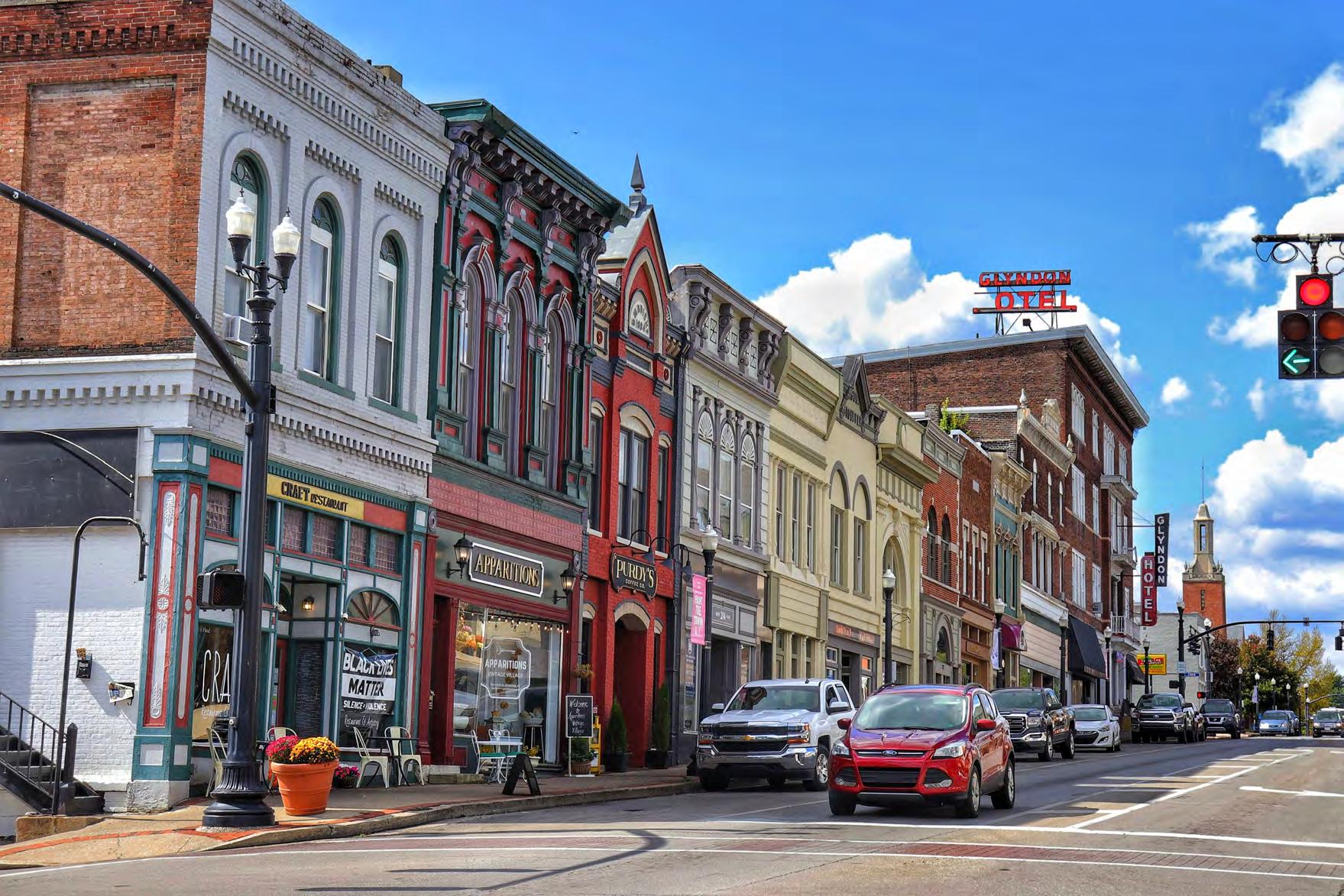


NEW ORLEANS ( left)
Corbin resident Donna Vance enjoyed the laidback vibe while visiting the city known for its diverse culture.

Ed and Delinda McDermott of Paducah visited Hawaii Volcanoes National Park on Hawaii Island, also known as the Big Island.

The Isaac family—Will, Julie and Katie—from Bowling Green ventured to New Mexico, where they are pictured at Santa Ana Pueblo, just outside of Albuquerque.
Kwiz Answers: 1. B. Although the U.S. had 18 states during the War of 1812, the U.S. flag had not changed since Kentucky became a state in 1792; 2. B. When Vermont and Kentucky became states, both a star and a stripe were added to the flag, which did not change for the next 26 years. In 1818, Congress passed an act giving each state a star and returning the stripes to 13 for the 13 original states; 3. C. Although Congress passed the Maysville Road Act in 1830, Jackson vetoed it, possibly as a jab to Henry Clay, who had cost Jackson his presidential election in 1824; 4. C. In 1809, Dr. Ephraim McDowell of Danville pioneered elective abdominal surgery by removing an ovarian tumor. Today, he is known as the “founder of operative gynecology”; 5. C. Because her only access to the federal coffers was money for maintaining the White House grounds, Mary Todd Lincoln sold manure and fertilizer to fund her somewhat lavish dinners there; 6. A. Although Andrew Jackson won the popular vote, he lacked a majority in the Electoral College, allowing Kentucky’s Henry Clay, as Speaker of the House, to use his influence in support of John Quincy Adams; 7. A. The George Washington was the C&O’s flagship passenger train that operated in Kentucky from 1932-1971. Passenger traffic ceased between Ashland and Louisville with the establishment of AMTRAK, but the link from Ashland to Cincinnati via Maysville, now known as The Cardinal, still has passenger service; 8. C. While Barkley was a Senate Majority Leader during the 1940s, he was Harry S Truman’s vice president from 1949-1953; 9. C. The 1965-1966 University of Kentucky basketball team, known as “Rupp’s Runts,” lost to Texas Western in the NCAA Championship, 72-65. UK had beaten Duke two days earlier, but members from both teams were suffering from severe flu symptoms; 10. C. While Kentucky’s state motto is “United We Stand, Divided We Fall,” the words on Kentucky’s limestone block in the Washington Monument reflect the Commonwealth’s position on states seceding from the Union, a political issue following Henry Clay’s “Compromise of 1850”; 11. B. Truman drank bourbon on a nearly daily basis, usually Old Grand Dad or Wild Turkey; while Eisenhower preferred Scotch, Roosevelt liked cocktails, and Obama favored beer; 12. A. Zachary Taylor, the 12th president of the U.S., lived on a farm near Louisville for 20 years before joining the U.S. Army in 1808. His tomb and mausoleum lie on a section of the original Taylor farm, which now is designated as a national cemetery.


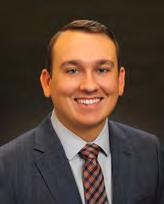





SERVES 8-10
8 ounces canned pumpkin purée
½ cup oil
2 eggs
1 cup sugar
1 cup flour
1 teaspoon baking soda
1 teaspoon salt
1½ teaspoons cinnamon
Cooking spray
Frosting (recipe below)
1. Preheat oven to 350 degrees.
2. In a large mixing bowl, combine pumpkin purée, oil and eggs. Stir in sugar, flour, baking soda, salt and cinnamon until well combined.
3. Lightly coat a 9- by 13-inch baking pan with cooking spray and pour in pumpkin mixture.
4. Bake for 20 minutes. Cool completely before frosting. To serve, cut into squares. Store leftover pumpkin squares in refrigerator.
Frosting
½ cup margarine
3 ounces cream cheese
1 teaspoon vanilla
1¼ cups powdered sugar (increase or decrease amount to achieve desired spreading consistency)
4 ounces (1/3 bag) semisweet chocolate chips
2 tablespoons margarine
1. With a hand-held mixer, beat together ½ cup margarine, cream cheese, vanilla and powdered sugar until smooth. Frost cooled pumpkin cake without removing it from pan.
2. Melt chocolate chips with 2 tablespoons margarine and stir to combine well. Drizzle chocolate over top of frosting.
From the family recipes of Business Manager Barbara Kay VestNo other holiday is savored by gastronomes quite like Thanksgiving. It is a glorious day of feasting, sometimes to excess. It’s also a family affair, where family—and friends who are welcomed as family—travel sometimes many miles to gather, express their gratitude, and enjoy a meal prepared by loving hands. It is common for families to have certian dishes that appear every year on their Thanksgiving dinner tables. This month, our staff—aka our Kentucky Monthly family members—share their favorite family recipes.

1. Preheat oven to 350 degrees.
2. In a large bowl, combine sweet potatoes, milk, sugar, butter, eggs and vanilla. Pour mixture into a greased 2-quart casserole dish.
3. In a separate bowl, combine brown sugar, flour, butter and pecans. Sprinkle topping mixture over sweet potatoes.
4. Bake in preheated oven for 40-45 minutes. Check after 30-35 minutes. If casserole appears to be getting overbrowned, cover with aluminum foil to finish baking.


SERVES 6-8
3 14-ounce cans green beans—fresh cut or French style, reserve liquid
4 teaspoons cornstarch
1 teaspoon salt
1 teaspoon dry mustard
2 tablespoons brown sugar
2 tablespoons vinegar
6-8 slices thickly sliced bacon
1 medium onion, diced
1. Drain green beans, reserving one cup of liquid. Add water if reserved liquid does not fill one cup.
2. In a bowl, whisk together bean juice, cornstarch, salt, dry mustard, brown sugar and vinegar until smooth. Set aside.
3. Fry bacon until almost crisp. Remove from the skillet, leaving the rendered grease. Add onion to bacon grease and cook until onion is lightly browned.
4. Pour the green bean juice mixture into the skillet with the onions and cook, stirring constantly, until the mixture boils and thickens.
6. Pour green beans into a Dutch oven or a large pot and pour contents of skillet over the beans. Simmer until beans are hot.
7. Crumble bacon over the top of green beans just before serving.

8. Serve immediately or refrigerate overnight or until ready to serve.
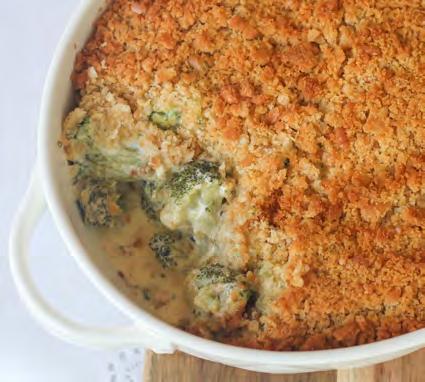
SERVES 8-10
20 ounces frozen broccoli crowns
1 cup mayonnaise
2 eggs, beaten
1 can cream of celery soup
½ pound Velveeta, cubed
1½ sleeves Ritz crackers, crushed
2 tablespoons butter, melted Cooking spray or butter
1. Preheat oven to 350 degrees.
2. Cook broccoli according to package directions until almost done, allowing the broccoli to remain firm and crisp.
3. In a large bowl, combine mayonnaise, eggs, soup and Velveeta, stirring well. Fold in broccoli.
4. Add melted butter to cracker crumbs in a medium bowl and stir well to combine.
5. Pour broccoli mixture into a 2-quart casserole that has been coated with cooking spray or butter. Top with cracker crumb mixture.
6. Bake in preheated oven 25-35 minutes, until cracker topping is browned and casserole is bubbly.
Note: While our original family recipe calls for salad dressing, I prefer mayonnaise. Home chefs should feel free to use their preference here.
SERVES 6-8
4 cups cornbread, crumbled
5-6 biscuits, crumbled
3 chicken breasts
3-4 tablespoons chopped onion
1 teaspoon black pepper
1- 2 tablespoons sage
6 cups chicken broth, hot (can be canned or mix store-bought broth with the broth rendered from boiling chicken)
1 can cream of chicken soup, added to broth
1 cup finely chopped celery
2 eggs
1. Preheat oven to 400 degrees.
2. Make homemade cornbread and homemade biscuits prior to prep day. These can be frozen ahead.
3. Boil chicken breasts until meat is tender. Remove chicken from broth. When cool, shred chicken and set aside.
4. Combine cornbread crumbles, biscuit crumbles, onion, sage and black pepper. Add hot broth slowly, then add remaining ingredients, including chicken.

5. Pour mixture into a greased large baking dish and bake for an hour or until it is brown and crispy on top.
Notes: The mixture will look thin when pouring into the baking dish, but don’t worry; it will be good and moist when finished!
We sometimes use only half the chicken in the dressing and the other half in the dumplings. You can vary according to your taste. Add leftover sausage, mushrooms or whatever your family enjoys!

SERVES 8-10
1 8-ounce container Cool Whip Lite
1 16-ounce container frozen strawberries with juice, thawed
1 20-ounce can pineapple tidbits, drained
1-2 bananas cut into small pieces
1. Combine all ingredients in a large bowl, mixing well.
2. Pour mixture into a 9- by 13-inch Pyrex baking dish, cover and place in freezer until completely frozen.
Recipes provided by Kentucky Monthly staff members and prepared at Sullivan University by Ann Currie Photos by Jesse Hendrix-Inman.

An all-female Honor Flight gave a long-overdue gesture of thanks to Kentucky women who served in America’s armed forces.
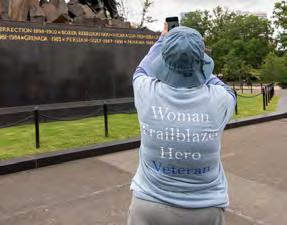
“They need to know how much we appreciate them and that their service made a lasting impact within the military and for future generations of women.”
ASHLEY BRUGGEMAN, FLIGHT DIRECTORLaden with camera bags and coffee, I took a seat next to West Point graduate Carolyn Furdek and her mother, Margaret Logan, on Kentucky’s first all-female veteran Honor Flight on the morning of June 11. I knew the friendly women were decorated veterans with a stash of stories told and untold about their service in the Army, and a rare thing happened: I became shy.
My eyes were drawn to the bracelet on Furdek’s wrist. After a few minutes of pleasantries discussing our families and this great adventure on which we were about to embark, we taxied through a water cannon salute on a chartered American Airlines flight bedazzled with American flags, departing Blue Grass Airport en route to Reagan National Airport in Washington, D.C., for a day of honor for some of Kentucky’s bravest women. I eventually got the courage to ask Furdek about her bracelet.
It bore the memory of Laura Walker, a fellow officer and West Point grad, and Robert Davis, a soldier she had known for three years and very much respected. “He had just returned from a two-week leave to meet his newborn son,” Furdek said of Davis. “Laura and Robert were both in our unit and in my company. They were killed in 2005 during my second deployment to Afghanistan.”
Furdek, 44, is the mother of two boys. We joked that she had broken the streak of female veterans in her family by having sons and that perhaps she needed to adopt a daughter. Her mother’s mother also served in the military. Furdek worked as an engineer officer—with deployments in Iraq and Afghanistan from 2000-2006— rose to the rank of captain, and earned a Bronze Star, among a long list of accomplishments.
For her and the other 133 women on Honor Flight Kentucky, this day was a chance to remember, heal
and move forward, while soaking up the appreciation for their service. The Operation HERoes Honor Flight was coordinated by Honor Flight Kentucky and sponsored by the Kentucky Department of Veterans Affairs (KDVA), the Kentucky Historical Society (KHS) and UPS.

From the moment we touched down at DCA, the day was a masterful feat of coordination and hospitality, beginning with a visit to the Women in Military Service for America Memorial. The next stop for our chartered buses was the changing of the guard at the Tomb of the Unknown Soldier, the World War II Memorial, Marine Corps Memorial, Korean War Veterans Memorial and Vietnam Veterans Memorial, where the women participated in an emotional wreath-laying ceremony to honor the 265,000 women who had served there.
I held my emotions together until that point, but the stories got me:


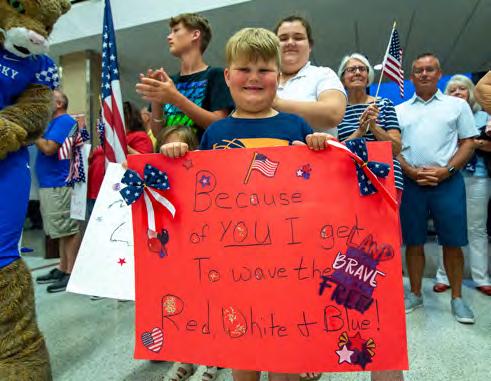







women who fought to receive recognition, lost countless friends, helped identify the bodies of soldiers and then prepared their remains to ship home. Some of these women didn’t speak about their traumatic experiences for decades.

The evening prior to the flight, the KHS hosted a dinner with keynote speaker Gen. Lori Robinson, USAF (Ret.), the highestranking woman in United States military history as the former commander of the North American Aerospace Defense Command and the U.S. Northern Command.
• • •
The story of one life shaped by war is that of Ashley Hawkins. She served in the Army in Baghdad, Iraq, as a Military Police Officer, conducting route patrols, securing routes for convoys, scanning for improvised explosive devices (IEDs), and protecting military personnel and civilians. Hawkins is the first woman to be awarded the
Bronze Star Medal with Valor Device after the infamous Palm Sunday Ambush in 2005. She called the award an honor, and, during her visit to the Women in Military Service for America Memorial, she was able to honor a friend who was in the ambush. Hawkins, 38, has the photo on her phone of her friend that was recreated in a drawing at the memorial in a series of artworks. She said that she was “thrilled to see [her friend] there.”
HFK enabled her to reconnect with her experiences and interact with Kentucky women veterans who she said had paved the way for her to serve. According to the Pew Research Center, since the U.S. military established an allvolunteer force in 1973, the number of women serving on active duty has risen dramatically. The share of women among the enlisted ranks has increased from 2 to 14 percent, and the share among commissioned officers has quadrupled, from 4 to 16 percent.
“Just thinking about that day
brings a smile to my face,” said Hawkins, who recently was treated for breast cancer and was diagnosed with post-traumatic stress disorder. She was welcomed back home at LEX the evening of the Honor Flight by her husband and five children. She said she hopes all of her children, especially her two daughters, are emboldened by her career and forge the paths they want for their own lives—whether that’s working as a housewife or an Apache helicopter pilot.
Hawkins has worked for years to ensure female veterans are seen and heard. “It’s about [fixing] the assumption … If I ask for a military discount at a store, they look at my husband and say, ‘Thank you for your service.’ It’s not an insult, but my husband didn’t serve,” she said.
Kentucky Historical Society Foundation Director Doug High, who helped coordinate Operation HERoes, also hopes to help female veterans get the recognition they deserve. It’s personal for him. “As a
veteran of Afghanistan and the War on Terror and throughout my 21 years of service in the Navy Reserve, I have been keenly aware of how important our female service members are to the mission,” he said. “I’m painfully aware of what my female colleagues have gone through—the service and sacrifice, the brick walls and scaling mountains of inequality and harassment and worse. We owe them a huge thanks. It was incredibly humbling to be in the presence of these women who did nothing less than change the world.”
He recalled observing the women as they interacted with each other at the monuments. “Their strength— collectively and individually—just radiated off of them,” he said. “It was inspiring and infectious to be near. And what moved me the most was just how grateful these veterans were for us to be honoring them and caring for them. They seemed so overwhelmed, more so that all male Honor Flights I’ve been a part of, and our love and attention for them seemed so surprising and unexpected. That hurt me to see. As a veteran, I’m thanked often, and I greatly appreciate it. I got the sense from their surprise and their reactions that this hasn’t been the case for many of them.”
• • •
Operation HERoes brought out stories of courage and fortitude, such as tales of escaping enemy gunfire, identifying dismembered bodies, comforting dying soldiers, delivering babies in war zones, going dark on a ship for weeks after it was bombed, and countless other experiences from the Vietnam War to the War on Terror.
“I loved watching the wreath laying at the Vietnam Women’s Memorial. Watching them embrace and look into each other’s eyes with that look of ‘I know’ … It was beautiful,” flight director Ashley Bruggeman said. “There’s healing in community, and that’s such a large part of why Honor Flight makes a difference. Two of the veterans on the flight—one currently living in Kentucky and the other in D.C.— had attended Basic Training together and hadn’t seen each other
in over 30 years. I can’t think of a better way to reunite.”
Honor Flight is a nationwide network of independent hubs serving veterans in their states. Bruggeman’s involvement with HFK began after her Junior League of Lexington work helped award grant funds to HFK. She then began volunteering and is wrapping up a term on the Board of Directors.
Bruggeman’s “onboarding” began in 2019 with a conversation with George Campbell, one of the late founding members. He and another founding HFK member, the late Phill Pittman—both Vietnam veterans—equipped her for the role, and she called their passing within six months of each other a “monumental loss.” Planning Operation HERoes took a year.
“At the airport in D.C., once we finished handing out mail-call bags and the veterans were boarding the flight, I sank down where I was standing and just sat on the ground in front of our gate,” Bruggeman said. “I was completely exhausted. One veteran sent me a text message as soon as she passed by to board. Her number wasn’t saved in my phone, and for some reason, my phone showed it as ‘Maybe Phill Pittman.’ The text said, ‘Well Done! Hooah!’ And the tears poured down my face. It was like receiving a giant hug from my late friend.”
Following the quiet evening flight home was a welcome party at LEX that I will never forget. Stepping off the plane, we prepared to travel a surreal, reverse-direction passage through airport security behind a row of bagpipes and flags. Hearing the large crowd and readying my cameras to document what I could with eyes blurred by tears and exhaustion, I was struck by the meaning of the day and how “normal” the women I boarded the plane with that morning had seemed. Many of them appeared to be like me, but appearances can be deceiving, and their stories raced through my mind as I passed cheering throngs to capture their return home.
“I hope that, as we approach Veterans Day, we’ll all consider that veterans often look different than what we expect,” Bruggeman said, noting that she often sees younger


female veterans go unacknowledged.

“The young mom wrangling a few little boys in the grocery store or the woman walking alongside her husband, a fellow Vietnam veteran, who served during the same period and witnessed similar horrors. It’s time we show appreciation for these women who so easily blend right back into civilian life. They need to know how much we appreciate them and that their service made a lasting impact within the military and for future generations of women.”
Furdek said the experience drove her to get more involved, and she hoped it will inspire more people to serve in the military. Furdek and Logan enjoyed the day together and met new friends.
“There is a kinship that veterans share and a mutual respect for one another,” said Logan, who worked as a nurse in multiple capacities from 1973-2001. “To see so many women veterans together on the Honor Flight was awesome. And meeting one of the female sentries at the Tomb of the Unknown

Soldier was a highlight. So many doors have been opened by women in my lifetime. Seeing women honored as well as men at the Vietnam Memorial spoke to my generation of nurses. Eight nurses died in Vietnam. Their names are on the wall.”
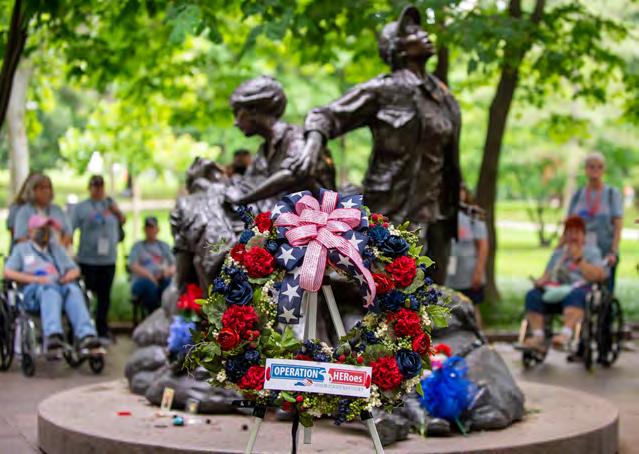
“My goal in planning this flight was to do everything I could to ensure these veterans know they’re loved and that their service mattered,” Bruggeman said, “and to be able to hug all 134 of them was the icing on the cake.”
Q
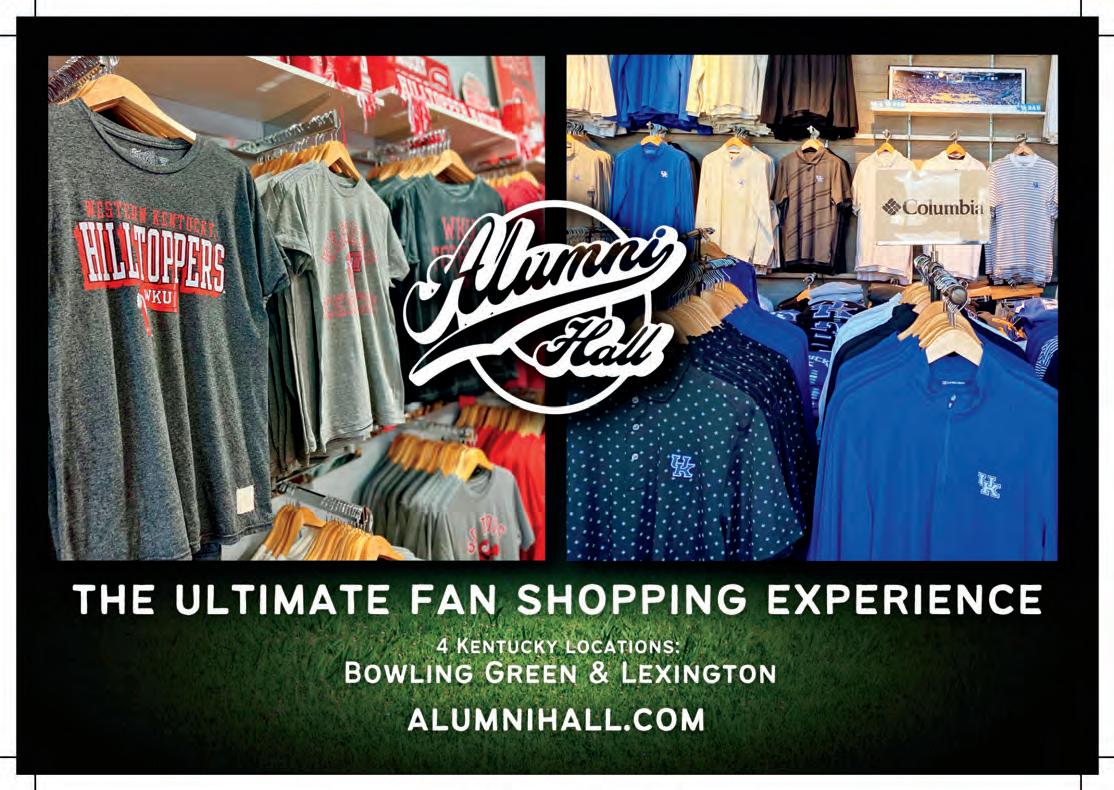






Sometimes, people need a simple reminder. Sisters Raegan and Rylyn Richins have that idea in mind when they hand paint their “Be Kind” signs. The Oldham County girls create the signs and sell them, with proceeds going to local charities.
“Our goal originally was 60 signs, and now—4,700 signs later—here we
are,” said Rylyn, 11.
The girls have siblings with Down Syndrome, and they had witnessed behavior toward Leena, 14, and Liam, 10, that was not always kind. One day in 2019, they saw similar signs in another county and came up with a plan to make their own.


Raegan and Rylyn decided to make each sign unique. “There is not just
one way to be kind,” said Raegan, 13. “There are so many ways to show kindness to others, so that is why all of our signs are different.”
Painting the signs is a family affair. Parents Ryan and Rhonda assemble the supplies and apply the base coat, while Raegan and Rylyn choose the colors and paint the design. Raegan explained that Leena

and Liam come along to lighten the mood. In July 2021, the family experienced the tragic loss of another sister, Kendall, who was 16.
“We continue to do what we do with joy and peace because we know where we are, and we know where [Kendall] is,” Rhonda said.
Through their grief, the Richins family spreads kindness.

• •
•
The girls’ signs dot the landscape of their home county, and their efforts have resulted in La Grange being nicknamed The Kindness Capital of Kentucky by several media outlets. The producers of NBC’s Today Show caught wind of Raegan and Rylyn’s initiative and featured a segment on them. NBC also distributed Be Kind
signs to its staff around the country and created a Be Kind billboard in New York’s Times Square.

The girls also caught the attention of the HGTV show Home Town Kickstart, presented by People magazine. The series, which features celebrity rehabbers Ben and Erin Napier, sent a team to La Grange to renovate a home and create a community gathering space, which serves as an incubator for small businesses. The third Home Town Kickstart project was to create a downtown mural designed by Liz Richter, a Louisville artist, that incorporates Raegan and Rylyn’s Be Kind message.
The mural was unveiled in May on an episode titled “Love for La Grange.”
“Seeing it firsthand is beautiful,” Rhonda said. “It is
breathtaking, rewarding, and fabulous to know that the girls are a part of it.”
• • •
Rhonda said that, while the project started as sign painting, it has opened other doors. “It started as a sign that said two words, painted by these cute girls who were 7 and 9 years old,” she said. “But it is no longer just about the signs.”
Now, the girls are being asked to spearhead other service projects in the community, and groups—such as the Boy Scouts and Girl Scouts—have helped them paint signs and asked how else they can get involved. “That shows the ripple effect of kindness,” Rhonda said.
Raegan said that, during the Kindness Campaign (as she refers to it), she has become kinder, and her patience has grown. The middleschool student hopes to pursue a career helping people with special needs. Rylyn, who started middle school this year, is undecided on her career path but is interested in clothing design and mortuary science.
“This shows that anybody can volunteer their time, and anybody can change a community,” Rhonda said of the Kindness Campaign. “And it shows that, when you do good things, good things happen.”
Louisville artist Liz Richter, 36, was thrilled when she was contacted by the producers of HGTV’s Home Town Kickstart about painting a mural for La Grange. She was familiar with Raegan and Rylyn’s signs because she had seen them around town but did not know the story behind them.

After meeting with the girls, whom Liz described as “incredible,” she looked at their sketches of what they envisioned in a mural at the corner of South Walnut and East Walnut.
The sisters had the idea to make the mural interactive, prompting people to stand in the place of the letter “I” in “KIND” and take photos. Raegan and Rylyn drew the outline of the state of Kentucky and the phrase “Kindness Capital of Kentucky,” including their signature bee where La Grange appears on the map.
“We combined my aesthetic and what I do with their original sketch,” Richter said. “All of the text was their idea, and the florals are kind of my signature.”
Richter explained that she included coneflower, a symbol for strength and health; Kentucky’s state flower, goldenrod, for happiness; bluebells for kindness; and the wild rose, which signifies love and is a special symbol for the Richins family to represent their loss.
“I also included a butterfly in flight for the philosophy that small acts of kindness can have a ripple effect over time,” Richter said.
Richter has years of experience painting murals and would love to create more in other communities. “My heart and soul are in small towns. I was born in Paducah, so I’m a rural girl at heart,” she said. “Each town has its own beautiful identity, and, as an artist, I can help tell those stories.”
Home Town Kickstart was filmed from mid-December to mid-January, and Richter acknowledged that was the worst time of year to paint an outdoor mural. “We had a lot of interesting challenges due to the weather,” she said. “We literally had icicles running down the wall, the paint was freezing, and, one time, I left all my brushes in the car and my bucket turned to solid ice. There were a lot of funny, interesting things happening behind the scenes.”
Despite the temperature issues, Richter said she had a great team and received support from the city of La Grange. “When people ask me about the show, I tell them it is reality TV,” she explained, “but the Richins family, they are as real as it gets.”

Oone of the Home Town Kickstart projects in La Grange is a milelong walking trail that winds around the Main Street buildings. Meant to beautify downtown as well as educate residents and visitors on the history of La Grange, Alley Loop links the new Springs Park and the Oldham County History Museum on one end of town to the La Grange Railroad Museum on the other end.
Still a work in progress, the path features murals by various artists with inspirational themes, particularly focusing on kindness. Retail shops, restaurants, art galleries and Airbnbs eventually will be along the trail.

A big reveal of the initial phase of Alley Loop took place on Oct. 8 with the first annual Alley Loop Festival. For more on the path, visit touroldham.com/venue/alley-loop.


We come from all across Kentucky to The Gatton Academy on the campus of Western Kentucky University. As juniors and seniors in high school, we enroll in WKU courses, conduct research with WKU professors, and study abroad. While we are challenged academically, we thrive in a supportive environment designed just for us and make lifelong friends. Best yet, our tuition, meals, housing, and fees are all paid for by the Commonwealth of Kentucky. You, too, can have a future filled with infinite possibilities.
WEBSITE: wku.edu/academy / EMAIL: academy@wku.edu / PHONE: 270-745-6565 facebook.com/gattonacademy @gattonacademy @gattonacademy




“We want all students to know that at Cumberlands there is a clear and a ordable path to a college degree. That’s the Cumberlands Commitment.”
-President Larry L. Cockrum
This wasn’t just any meeting.
In 1887, a few men representing 18 churches came together and committed to do something once and for all to help provide higher education throughout the struggling Appalachian area. By the end of the following year, they had successfully pooled their ideas and resources and founded a new college called the Williamsburg Institute.

For the first time, the region’s youth wouldn’t have to travel far away for a higher education and, more often than not, never return to Appalachia. Instead, they would have a college right in their backyard. What better way to encourage young people to invest their new knowledge and skills in the region that needed it most? What better way to help generations of Appalachians make better lives for themselves and their families?
That was the notion, and time proved it true.
The first four graduates became a doctor, an attorney, an educator, and a minister, spending the rest of their lives meeting the needs of people in their communities physically, legally, educationally, and spiritually. Generation after generation graduated from the school and – like those first four graduates – were better prepared for lives of leadership and service in their respective regions and around the world.
Over time, that small college in Kentucky grew and thrived. Students from other regions began attending because of the promise it offered. Eventually, it became a four-year college, and then began offering postgraduate and even online programs. Its name changed too; today, it’s known as University of the Cumberlands – one of the largest private universities in Kentucky.

The driving purpose of education is community enrichment. Since its beginning, Cumberlands has poured into students so students can in turn pour into their families, careers and communities. Today, the graduating classes are a bit bigger than four people. The campus looks different too - and we’ve cut tuition by 57 percent and given free textbooks to on-campus students. But the heart of the university rests on its original founding purpose: to provide a first-class education at rates within the means of the region’s young people. In other words, offering promising students of all backgrounds a well-rounded academic experience enriched with Christian values so they have what it takes to strive for excellence, lead with kindness, and give through service.
That’s what
A seventh-grade class in Owen County led a campaign to recognize a nearly forgotten admiral and Olympic athlete from their hometown

In the front yard of the old Owen County Courthouse at the corner of West Seminary and North Thomas streets near a large tree in the quiet community of Owenton stands Kentucky historical marker No. 2521. It honors an Owen County native whose worldwide accomplishments might have faded from public memory had it not been, in large part, for a group of middle-school students whose teacher had read a newspaper story about littleknown Willis Augustus “Mose” Lee Jr., one of Kentucky’s greatest veterans.
Many Kentuckians had never heard of the man who won the highest number of Olympic medals from the Bluegrass State, served on two destroyers during World War I, and commanded American battleships during the pivotal Battle of Guadalcanal in the South Pacific during World War II.
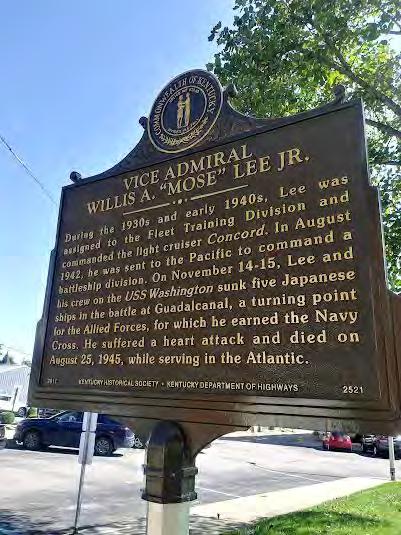
A native of the Owen County community of Natlee on Eagle Creek, about 13 miles southeast of Owenton, Lee grew up in the small town (the population today is 1,754) and became a vice admiral in the United States Navy. He was so successful that he was lauded by President Franklin Delano Roosevelt and British Prime Minister
Winston Churchill. A few years after the war, the Navy thought so highly of him that it named a destroyer in his honor. The USS Willis A. Lee participated in the blockade in the 1962 Cuban Missile Crisis, the most intense nuclear confrontation this world has ever seen.
But Lee’s name mostly remained shrouded in obscurity until a few years ago.
In July 2016, the Lexington Herald-Leader published a story about Lee, highlighting his military career and his winning seven medals (five gold, one silver, and one bronze) for marksmanship at the 1920 Olympics in Antwerp, Belgium, as a member of the U.S. rifle team, even though he wore thick glasses after black powder blew up in his face as a boy.
The story had been suggested to the newspaper by David Fleenor, a Lexington attorney and general counsel for the Kentucky Senate who had graduated with a bachelor’s degree in history from the United States Naval Academy in Annapolis, Maryland, in 1979.
• • •
The newspaper article attracted the attention of Denise Humphries, then a language arts teacher at

Maurice Bowling Middle School in Owen County. She designed for her seventh graders a series of activities through which they researched Lee’s background and contributions to state and national history.

“It’s amazing what happened,” said Humphries, who now is retired from teaching and is bookmobile librarian for the Owen County Public Library.
The students approached their Lee assignments with enthusiasm. One student delivered remarks about Lee to the local Rotary Club. The school’s entire seventh grade visited the Kentucky History Center in Frankfort to see Lee’s Olympic medals. The students participated in the application that eventually landed Lee in the Kentucky Sports Hall of Fame in August 2019.
The culmination of the students’ work was raising $2,500 to install the Lee marker at the old courthouse. A dedication ceremony for the marker on Sept. 16, 2017, featured Humphries, her students and some descendants of Lee. The Navy officer and his wife, Mabelle, never had children.
Some of Lee’s relatives donated several of his personal letters to and from his mother and wife, along with other memorabilia, to the county historical society.
A handwritten letter from his mother to Lee before he had garnered worldwide attention with his rifle team at the Olympics read, “My Dear Boy, Am sending your cake today. Look for it. Have you had your exams yet—do you get on the rifle team. Write and tell me.”

Bonnie Strassell, a planner for the Owen County Historical Society and a county library employee, said the society never would have gotten the Lee materials if the young students “had not told us more about this great man.”
“Until Denise and her students started their work on Lee, most of us in Owen County didn’t know much about him,” she said.
• • •
Paul Stillwell, an independent historian and retired naval officer from Arnold, Maryland, wrote a book last year about Lee called Battleship Commander: The Life of Vice Admiral Willis A. Lee Jr. He started working on it in 1975 but did not finish it until 2021. “Twelve other books got in the way,” Stillwell said.

“I have heard about the work of Denise Humphries and the young people in Owen County to research and educate people more about the importance of Lee,” Stillwell said. “I think that is marvelous.”
There are several reasons why Lee is not that wellknown, said Stillwell: “He shunned publicity. Unlike some other World War II greats, he wrote no memoirs and did not leave behind official papers. He was hesitant to be in the public eye. He was laconic in interviews.
“His wife inherited his possessions, but she died four years after he did and left them to family members.”
Lee should be remembered for his military accomplishments, said Stillwell. “He was a pioneer in

radar, gunnery and developing combat information centers,” he explained. A combat information center is a room in a warship used as a tactical area and provides processed information for command and control of the nearby battle space or area of operations. Lee made good use of the centers as a battleship commander.
Stillwell said that, in writing the book, he conducted many interviews of people from Owen County and those who worked with Lee and his relatives “to flesh him out as human being.”
“Lee was not an assertive man, but he knew how to command,” said the author.
When asked what he would ask Lee if he had a chance to interview him, Stillwell replied, “Oh, I would want to hear his accounts of all the military events he was involved in.”
• • •
Lee’s childhood nickname of “Mose” originated from his mother, who was fishing at Eagle Creek but had to be rushed to her family home in Natlee to deliver her son. She joked later that she might name her son Mose because she had taken him away from the water, as Pharaoh’s daughter had rescued the biblical Moses
Lee graduated from the U.S. Naval Academy in 1908. Following graduation, Lee excelled on rifle teams, and from October 1908-May 1909, he served on a battleship. He later served on a cruiser and a gunboat. During World War I, Lee served on two destroyers.
During the 1930s and early ’40s, Lee served several assignments in the Fleet Training Division. In early 1942, following his promotion to rear admiral, Lee became assistant chief of staff to the Commander in Chief, U.S. Fleet.
When his vessel fought a Japanese battleship on the night of Nov. 14, 1942, in the waters of Guadalcanal, he became naval history’s first battleship commander to conduct a “gunfight” primarily by radar. He received the Navy Cross for his actions in a battle that was a turning point for the Allied forces in World War II.
In 1944, Lee was promoted to vice admiral and placed in charge of the Pacific Fleet’s fast battleships. In May 1945, he was sent to the Atlantic to command a special unit researching defenses against the threat of Japanese kamikaze aircraft.
While serving in that position in Casco Bay, Maine, on the morning of Aug. 25, 1945, Lee walked 15 minutes from a boarding house where he had had breakfast with his wife to a small boat for a trip out to his office on Great Diamond Island. Moments after the boat pulled away from the landing, Lee began choking. He slumped over his seat. The boat crew rushed to help him and tried to get him to the nearest ship for help.

Lee died of a coronary thrombosis at 66. His death came 10 days after the surrender of Japan. He was buried at Arlington National Cemetery in Washington, D.C.

“The man of huge ships died in a boat,” Stillwell wrote in his book. “The splendid warrior died with the coming of peace.”



• • •


Teacher Humphries said there were two major takeaways from the experiences of her students, now out of high school learning about Lee. “First, they realized a person from a small town like Owenton can do great things, as Lee did,” she said, “and they also realized that, no matter how small a person’s voice is, he or she can make things happen. They did.
“I think the great man would have been as proud of them as they are of him.”

A northern Kentucky organization gathers products from big corporations and distributes them to small nonprofits to help them serve their clients
Master Provisions in northern Kentucky acquires food and clothing from corporations and organizes the items for pickup by nonprofit organizations. It’s a trusty bridge between those that donate goods and those that need them.


“Instead of each nonprofit approaching a store for merchandise, our job is to run our 26-foot box trucks and semi-trailers to the [Master Provisions] distribution center,” said Roger Babik, the organization’s founder and president. “The average nonprofit is in no way equipped to make major pickups.”
Master Provisions gets trucks full of fruit, vegetables and other foods from groceries and containers with leftover merchandise or broken packaged goods. Babik explained that these are good-quality items from major companies such as Kroger, Amazon, Pepsi and Frito-
Lay. “Amazon won’t even warehouse items that have less than six months until the sell-by date,” he said. “So, some of the stuff they send over have five months until the sell-by date, and they just donate it to us.”
Perishable items, such as fruit, come in and go out on the same day. Master Provisions can store beef, pork, chicken and ice cream in its walk-in refrigerators and freezers. It receives 50-pound containers of rice, beans and pasta, which are broken down and packaged into smaller portions for the nonprofits.
Skids and pallets full of products are sorted daily by volunteers, and then representatives from organizations such as food pantries and soup kitchens arrive at the warehouse to gather food for distribution.
Some 15-20 nonprofit partners are scheduled to pick up items at the
Master Provisions warehouse each day, and the camaraderie is friendly among the organizations and the volunteers. As the nonprofit partners walk the aisles with pallets, they can take whatever they need—but only up to 50 percent of one item. For example, if there is a shelf full of shampoo, one organization can take half the items on the shelf but must leave the other half for other organizations. Babik said this builds a share mentality.
When the representatives have what they need, the items are weighed, and the nonprofit is charged 15 cents per pound for the goods. Babik explained that it costs Master Provisions about 23 cents per pound to run the trucks and store the food, so the 15-cent-per-pound payment
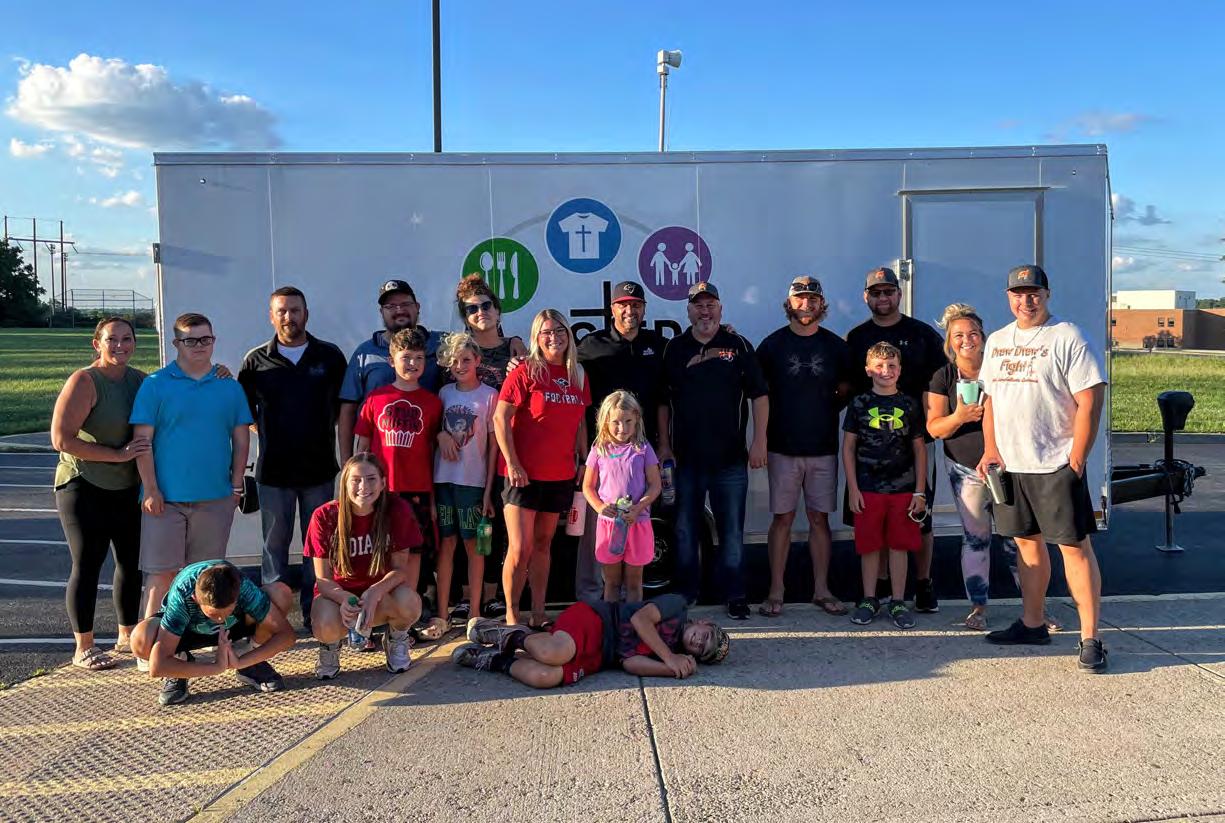
helps defray expenses. By teaming up with around 240 ministry partners in 52 counties, Master Provisions serves more than 68,000 people each month, Babik said.

One of Master Provisions’ partners is FUEL NKU, a food pantry for Northern Kentucky University students. A representative comes to Master Provisions each week and purchases about 1,000 pounds of food and hygiene items. FUEL NKU, which is open five days a week, averages about 180 students per day. “The ability to get all this food for 15 cents per pound is second to none for us,” said Nick Bliven, the FUEL NKU program coordinator. “It really helps us in our effort to support student needs.”
The pantry is open year-round to anyone who needs it and is enrolled in classes at the university. Bliven said that no other questions are asked of those who visit. “In addition to energy drinks, produce and bread items, they also supply us with specialty food like gluten-free items and health foods, which so many of the students are looking for. Master Provisions is a fantastic partner.”
Babik said that, while Master Provisions is faith-based, it is not affiliated with any particular church and works with a variety of denominations. “I never force my beliefs on anyone. All that does is create a wall,” he said. “I might share my beliefs but then ask them, ‘What do you believe?’ Even if they don’t believe in God or the Bible, they believe in being compassionate, kind, humble, gentle and patient. It
receive 40-60 pounds of food each month from these visits.


Babik started Master Provisions in 1994 with a focus on distributing used shoes and clothing internationally, starting with Ukraine after the fall of communism. It added other countries and began supporting orphanages. After about 20 years, the organization added another layer to its endeavor. “In 2013, we saw a hole in our ministry. There was a gap that we weren’t serving people here in our backyard,” Babik said. “We built an infrastructure of trucks and our warehouse, so that we became a resource to other nonprofits.”
They continue to operate their international outreach programs today. “We take care of about 300 kids in Ukraine, 100 in Guatemala, 30 in Togo,” he continued. “We help educate, provide housing, and help with adoption services.”
Master Provisions orchestrates shipping containers of clothing overseas. It clothes many people in


Togo. But if the clothing is unusable or culturally inappropriate, the organization shreds it and uses it as stuffing or filler. Nothing goes to waste.
Lighter-weight clothing is slated for warm-weather countries. Winter clothing stays in the local community or is sent to the Appalachian region. Master Provisions has an ongoing relationship with Manna From Heaven Outreach in Myra (Pike County). Once a month, a truck makes the eight-hour round trip between northern and eastern Kentucky.
Manna From Heaven’s co-founder, Lois Tackett, said that it is always a treat to see what is available, and she looks forward to sharing goods with the people who come to her food pantry and the organizations to

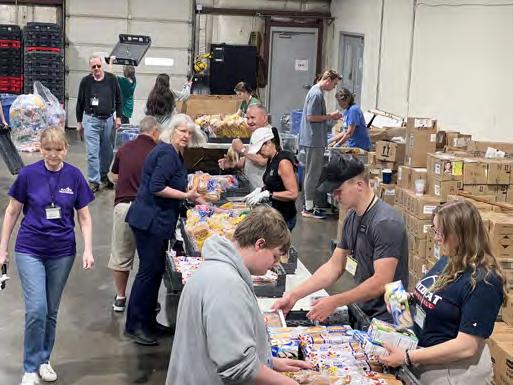
which she distributes, such as orphanages and veterans’ groups in multiple counties in the region. “We have people who need this food to survive,” she said. “They have to choose between paying for their medicine or food, so at least we can help with the food.”
After the devastating floods of last summer, eastern Kentucky needs more help than ever. Tackett, who had three feet of water in her house, lost all her furniture and a vehicle, but she continues to help others in the community through Manna From Heaven. “Master Provisions is a blessing to all of us,” she said. “We need prayers the most, and then we need anything to eat or tools to work with.”

Master Provisions currently is housed in a 17,500-square-foot warehouse, plus it has many offsite storage facilities. The goal is to find a 50,000-square-foot space where it can consolidate and grow, but Babik and company have not yet found such a location. A build-to-suit facility, which would require a fundraising campaign, is under consideration.
Babik is confident that the organization’s needs will be filled. “Our main focus is helping people who have food and clothing needs, and we do that to uplift them spiritually and physically,” he said. “At the same time, we also want to be of service to our nonprofit partners to make it easier for them to serve others.” Q







The Mettu Children’s Hospital at the Pikeville Medical Center officially opened its doors on Dec. 6, 2021, and immediately began admitting patients to its 10-bed facility. Over the past 11 months, most of those beds have been filled with patients who otherwise would have had to travel two to three hours away for in-patient hospital care.
“When you look at where we are located and draw a circle, it’s about a two- to two-and-a-half-hour drive in either direction for that type of care,” said Donovan Blackburn, the president and CEO of PMC. “You would either go to Lexington or Charleston or Huntington [the latter two in West Virginia].”
The 13,400-square-foot facility was designed to provide medical care suited to children’s needs. “We brought in all our pediatricians, and we brought in all our clinical folks, and said, ‘It’s your facility. Tell us what we need,’ ” Blackburn said.
“There’s a lot of extra things—like rounding off the seats and the toilets lowered … things you wouldn’t think about as a normal design.”
Included in that child-friendly hospital environment are 10 private patient rooms with two isolated, a family waiting room, and consultation, treatment, medication and nourishment rooms. The hospital’s outpatient service area consists of 13 exam rooms, along with sick- and well-patient waiting areas.
• • •
“You can walk into Mettu Children’s Hospital, and it’s such an impressive building and such an impressive presentation, that really you’d think you were at Cincinnati Children’s Hospital or Seattle Children’s Hospital, which are some of the best children’s hospitals in the world,” said Dr. Frederick Stine, Mettu’s co-medical director and pediatric hospitalist. “PMC wants to be able to provide expert-level care
and also world-class care to the people of this region. The Mettu Children’s Hospital was our way of making that promise to the community and to their families.”
Stine said the staff members are top-notch and are continually training to provide the latest innovations in pediatric care. “We’ve been doing education with our nursing staff and our ancillary staff to make sure we’ve got the best pediatric staff to support some of our sicker kids in our region, so they don’t have to travel hundreds of miles or two or three or four hours just to get the care they deserve,” he said.
While the hospital now eases the travel burden and the subsequent financial strain for inpatient pediatric care, the Mettu Children’s Hospital Specialty Clinic goes one step further. A collaboration between the Pikeville hospital and the University of Kentucky Children’s Hospital, the clinic brings
specialists in cardiology, pulmonology and endocrinology to Pike County at scheduled times each month. “[Now], our children who require those subspecialists don’t have to travel so far to see those folks,” Stine said.
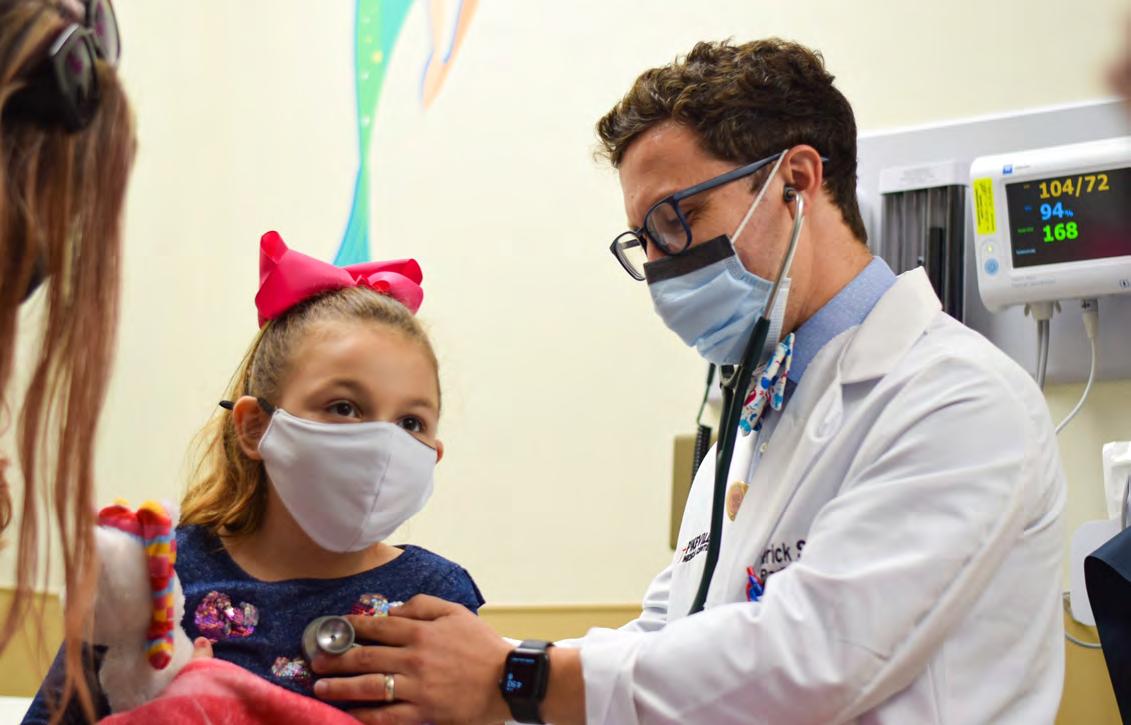
The new hospital and specialty clinic are part of PMC’s larger mission to expand pediatric care in eastern Kentucky. “Though we have great pediatricians not only in our organization but within the community, unfortunately, when there was a need for a higher level of care, a lot of the time, we had to send those patients out,” Blackburn said.
But in 2020, the Neonatal Intensive Care Unit, located in the main medical center, doubled in size from eight beds to 16, thereby advancing PMC to a Level II Advanced Care NICU.
“We now have the ability that, when babies are born at a lower birth
rate or premature, we’re actually able to keep them here at our hospital versus having to send them out to a higher level of care, which separates the mother and the family from the child,” Blackburn said.
• • •
PMC’s Emergency Department also has expanded to serve the younger residents in the region. Blackburn said the pediatric ER has its own entrance, a separate waiting area, child-friendly rooms, and activity centers. In 2019, those improvements earned the department the “Pediatric Ready” certification by the Kentucky Emergency Medical Services for Children Program. Only three other hospitals in the Commonwealth have that designation.
PMC also opened the Appalachian Valley Autism Center in 2021 “to ensure that we are paying close
attention to the neediest, more sensitive of our population—those individuals with sensory integration disorders,” Stine said.
The AVA Center provides several types of therapies tailored to the needs of each child, including applied behavior analysis therapy as well as speech, occupational, physical and feeding therapies.
Blackburn said all of the initiatives launched in the past four years, including the opening of the Mettu Children’s Hospital, are only the beginning of providing care for the region’s younger population. “I’m very proud of our work and our accomplishments and where we’re at today,” he said. “If we can take care of 25, 30 or 40 percent of our population without having to send them out, then that’s 25, 30 or 40 percent that will stay home.”
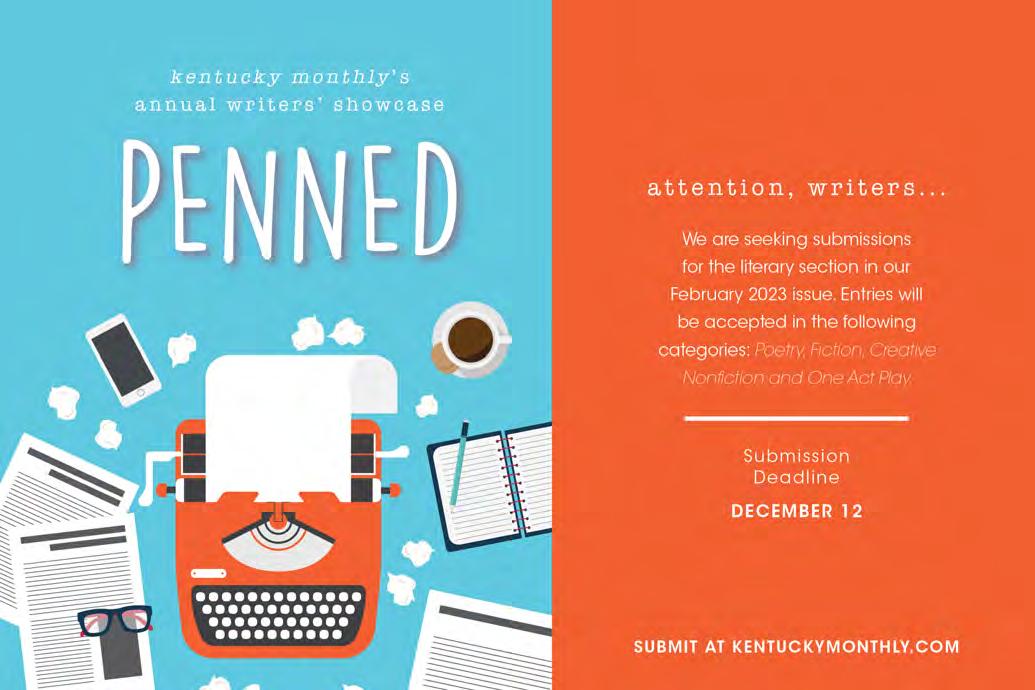
Named a Tree Campus Higher Education Institution by the Arbor Day Foundation

“Being a Colonel means more than just being a dedicated student. It also means to be helpful and caring to those around us and showing how proud we are of our beautiful campus.” - Alexis Naugle, ’20
Visit EKU GO.EKU.EDU/VISIT
Fall is the perfect time to visit Eastern Kentucky University. See for yourself why we call it the “Campus Beautiful,” experience our friendly and welcoming community, and learn more about EKU.
Just outside of Frankfort, tucked away beyond the bustle of U.S. 127 and I-64 traffic, sits Kentucky’s only sculpture park. In 2009, Melanie VanHouten transformed her grandparents’ tobacco farm into Josephine Sculpture Park, a place for the public to explore art and nature together.
For visitors who have been before and those who return time after time, there is always something new to see. The park does not have a permanent “collection.” Art on exhibit changes by the season or year. Familiar pieces may go “home” to their artists or be purchased by collectors, and new artwork will take their place.
Other familiar things have changed over the years, with the park updating its logo, website, maps and signage. “All these changes highlight the creativity and talent of our staff, partners and artists. What you experience here—for free—is on par with what you can find in bigname parks or museums,” said Jill Malusky, marketing and communications manager.
VanHouten explained the personal touch behind the new logo: “It has the real ‘Josephine’ in it—my
grandmother, who inspired me to create this place. The ‘JSP’ is from her signature.”

Nature and conservation are just as important as art, and visitors will see improvements to the landscape, along with new interpretive signage explaining these changes. In several locations, invasive species of plants are being removed and replaced with native species, restoring wildlife habitats and the health of the ecosystem. This hard work is undertaken by park staff and volunteers, along with local businesses such as Inside Out Landscape Design, and are supported by donors, including Richard and Anna Marie Rosen
.
Invasive honeysuckle bushes that once surrounded the park’s amphitheater have been removed by volunteers and woven into sculptural “people nests” that can be explored by visitors. Pollinatorfriendly trees and shrubs are being planted in their place.
Many of the park’s sculptures are not meant to be just seen; they are meant to be experienced. Climb inside Daniel Shieh’s “Sky Chamber,” “a secret space that takes visitors to a mystical place seemingly perched in the sky,” according to the artist.
Many of the park’s sculptures are meant to be touched or explored, and the signs noting each artwork’s name, artist and medium share this invitation.
Peyton Scott
Russell’s “GRAPHOLOGYHENGE” may be the best known for this. Any visitor is welcome to bring paint and make their mark on this graffiti sanctuary.


Representation is important to the staff and board of the park—from Kentucky artists to underrepresented communities. Artists in residence range from new and emerging artists to Guggenheim Fellows, TED speakers, and grant winners with exhibits at the Museum of Modern Art, Storm King Art Center and Smithsonian American Art Museum. Women and artists of color represent 55 percent of the works on exhibit and 65
percent of the resident artists at JSP. More than 1,000 artists from around the globe, representing 27 states and 15 countries, have exhibited and/or performed at JSP since its opening in 2009. The park also curates the Arts Downtown Exhibition in Frankfort’s business district, which features dozens of contemporary sculptures and murals.
The park’s existence as a nonprofit is made possible thanks to the steadfast support of volunteers, local businesses and donors. “I believe that my life’s work, my responsibility, is to create an enduring place that brings people together,” VanHouten said. “My desire is to help people feel more connected to each other and the natural world while they are at the park, so they can take those feelings with them as inspiration to make a difference in their lives as well.”


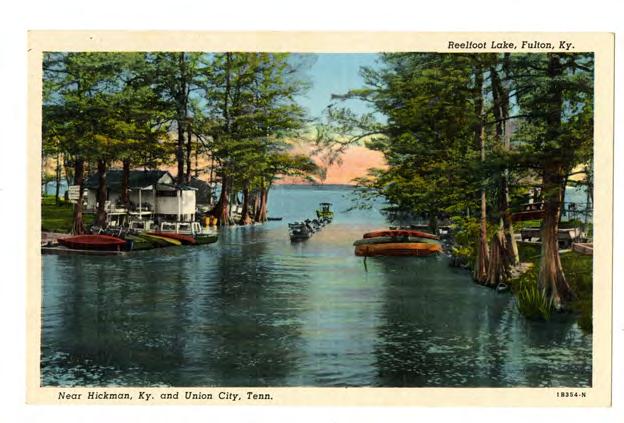





November is here and, although I love the colors of the season, my grass is covered in yellows, oranges and browns. I had two giant trees cut down this year, and what do you know? One was a pine, and the other was dead, but I have no fewer leaves than I had last year. Sigh.
We have an interesting story about tombstones this month. A marketing genius at an insurance company in the early 1900s thought to include a tombstone with every life insurance policy sold. The catch was that the stone had to include the company logo. I now have something to look for when I’m trying to get my steps in at the sprawling old cemetery near my house. We also have some soldierrelated stories, in honor of the 11th hour of the 11th day of the 11th month, known as Veterans Day. Thanks to all for their service.
In the “I Remember” column, Catherine Essex reminisces about Thanksgivings on the farm. Are you cooking for Thanksgiving? You’ll find my green bean recipe on page 10. Since I’ve made them for 30 years, I consider the beans a staple in my small collection of recipes. Whenever I get invited to someone’s home for dinner, they always say, “Bring your beans.” Although the beans are good, I suspect I get that repeat request because they know I don’t know how to make much else. Happy Thanksgiving to everyone.
I am looking for any information that would help me locate my great-grandfather. He may be Thomas Lacefield, and his wife, Elizabeth Crawford, but I cannot document them. Their son, Elijah Mansford Lacefield, was listed in a deed after his death that identifies him as the father of my grandfather, Robert Benjamin Lacefield
What is confusing is that the last name may have been Laswell and somewhere along the way was changed to Lacefield. Thomas Lacefield, b. 1780, married Elizabeth Crawford, b. 1785 in Shelby County, Kentucky, in 1805. Their children were William Crawford, Elijah, Mary Ann and Benjamin. Elijah Mansford Lacefield (Laswell), Oct. 15, 1833-Nov. 2, 1906. His first marriage took place in 1852 to Eliza Ann Moreland, 1831-? Their children were Isabel, 1853; George, 1855; and John, 1859. Eliza may have died after giving birth to John, since I do not see her after his birth. Birth records list George’s father as Elijah Laswell.
Elijah’s second marriage was on Feb. 22, 1860, to Mary Elizabeth Carleton, Jan. 11, 1840-July 6, 1911. Their children were William, 1860; Elijah, 1862; Susan, 1866; Jane, 1869; Anna Lee, 1873; my grandfather, Robert Benjamin, 1874; Charles, 1877; and Joseph, (?). They resided in and around Shelby and Anderson counties.
Any information you can provide will be appreciated.
Shirley Ann (Lacefield) Casey 6900 Hopeful Rd., Apt. 257, Florence KY 41042 shirleyanncasey@hotmail.com
Please send letters to Editor Deborah Kohl Kremer at deb@kentuckymonthly.com or mail to Deb Kremer, Kentucky Monthly, PO Box 559, Frankfort, KY 40602.

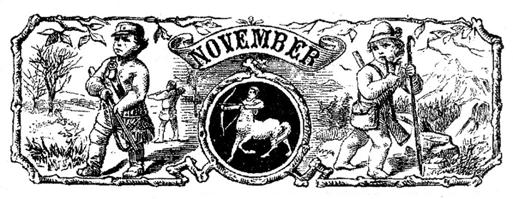
In the letter on ancestry (October issue, page 64), Germany should have been listed as the birthplace of Magdalena Senn
Have you heard about the far-reaching accomplishments of patriot Jack Jouett and the details of his thrilling ride?
John Jouett Jr., known as Jack Jouett, was born Dec. 7, 1754, in Albemarle County, Virginia. His father, John Jouett Sr., was a tavern keeper and American patriot. His mother, Mourning Harris, also came from a patriotic family. Jack and his three brothers all served in the Revolutionary Army or patriotic militia. Both John Sr. and Jack signed the famous Albemarle Petition, which renounced King George III and British control of the American colonies.
In 1779, the British Army made a fateful decision. Unable to subdue George Washington and the Revolutionary Army in the north, the British sailed to Virginia and the Carolinas hoping to divide the American colonies and destroy the revolution in the South. A British victory in Virginia, the home of Washington and Thomas Jefferson, would devastate the war effort.
On June 1, 1781, the British Gen. Charles Cornwallis learned that Virginia Gov. Jefferson and the Virginia Legislature had moved to Charlottesville, near Jefferson’s home of Monticello. Cornwallis sent Lt. Col. Banastre Tarleton to capture Jefferson and members of the legislature. If captured, Jefferson and the others faced imprisonment and death.
On the morning of June 3, Tarleton and his troops set out for nearby Monticello and Charlottesville, expecting to arrive by the next day. The British forces never suspected that a young patriot, Jack Jouett, would disrupt their plans.
According to legend, Jouett noticed Tarleton and the British forces as they passed the Cuckoo Tavern, a popular watering hole. Jouett had decided to sleep outside that night and was in a perfect position to view the British as they rode past. Jouett, a local with an intimate knowledge of the area, knew that the British were headed to Monticello and Charlottesville. Realizing that he had no time to spare, he immediately set out to warn Jefferson and the others. The night was dark, the route was dangerous, and he was 40 miles away.
Using an abandoned logging trail as a shortcut, Jouett faced difficult terrain. At one point, he was thrown from his horse. Debris struck him in the face, drawing blood and making his journey more difficult. Despite these challenges, he made it to the iconic Three Notch’d Road. Now on more reliable ground, he was able to move faster. Despite injuries that would scar him for life, Jouett made it to Monticello shortly before 4:30 a.m., before the British arrived Jefferson rewarded Jouett with a glass of wine and quickly packed up his household, making it to safety just before the British arrived. Jouett went on to Charlottesville, saving the lives of many, including the famous statesman Patrick Henry. Because of Jouett’s timely warning, the British mission was a failure.
On Oct. 19, 1781, only six months after the failed effort to capture Jefferson and the legislature, Cornwallis and Tarleton surrendered to a combined American and French force at Yorktown. Their surrender marked the end of major hostilities during the Revolutionary War and ensured American independence.
In 1782, Jouett moved to what was then Kentucky County, Virginia. He was elected to the Virginia House of Delegates, where he began a long career in politics. He went on to support Kentucky statehood, serving as a delegate to the Separation Convention in 1788. Thanks in part to his help, Kentucky secured its independence in 1792. Jouett went on to serve in the Kentucky House of Representatives, representing Mercer and Woodford counties.
Beyond his political career, Jouett was a successful farmer and equine enthusiast. Perhaps most notably, he helped create the first Kentucky Jockey Club in 1797. Similar jockey clubs spread throughout the state, eventually inspiring the most exciting two minutes in sports, the Kentucky Derby.
I often find myself speculating: What would have happened had Jack not made that ride? What if he had been captured, killed or even a few minutes late?
My mind immediately focuses on the obvious details, that Jouett’s heroic ride saved Jefferson and other patriots, and that he foiled one of the last British offensives in the Revolutionary War. He denied a British victory, a failure which, however indirectly, led to the eventual surrender at Yorktown. Knowing the later impact of Jefferson’s presidency, I also reflect on the Louisiana Purchase and the Lewis and Clark expedition. Both of these are monumental, the bedrock of our country’s history. I like to think that Jouett played a small part in developing that foundation. But his impact, his legacy, goes deeper than that.
Beyond war, beyond the Revolution, Jouett played an important role in the founding of Kentucky. His leadership and his reputation led to the creation of a new state. Behind that mythological bluegrass rests the stalwart legacies of men like Jack Jouett—men who were willing to risk everything for independence and the development of their chosen country.
Readers can visit the Jack Jouett House Historic Site at 255 Craigs Creek Road, Versailles, KY 40383. Find the Jack Jouett House on Facebook, Instagram, and through its website, jouetthouse.org. Tours are offered for free and can be scheduled through the website or by emailing info@ jouetthouse.org. Visitors will learn about Jouett, the settlement of Kentucky, and life on the frontier.
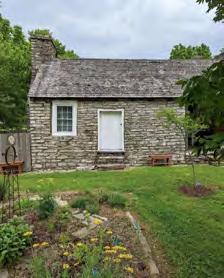
Woodford County’s Jack Jouett House: Home of a brave patriot and proud KentuckianThe Jack Jouett House. Photo courtesy of Adam Lewis
The calendar has been turned to November. The days are growing shorter, and the temperatures are turning cold. Winter is on the way.
As Thanksgiving Day approached during my childhood, there was a lot of activity on our family farm in Nelson County. Mom and Dad, known to the rest of the family as Uncle Buster and Aunt Nellie, provided the annual Thanksgiving meal. Our house was where the annual MattinglyMetts Thanksgiving meal took place.

The arrival of cold weather is the beginning of hog-killing time down on the farm. You might think the farm slows down in the winter, but there is still a lot of work to be done every day.
The work on the farm is hard in the wintertime. Battling the elements makes it rough on the livestock and the farmer. Days are spent feeding the livestock, milking the cows twice a day, and keeping the livestock sheltered from the weather. There is not much time to relax.
Come Thanksgiving Day, the big old farmhouse was filled wall-to-wall with people—from newborn babies to senior adults and all ages in between. The kitchen had every counter, table and extra space covered with food. Plates, napkins and silverware were waiting on the dining room table, along with glasses of tea, cups for coffee, and fresh milk from the morning milking.
My mother made desserts for weeks to get ready for the Thanksgiving meal. These included Mom’s favorite, white cake with coconut icing, blackberry jam cake made with chocolate and covered in chocolate icing. There were apple and cherry pies, blackberry cobbler and fried apple pies. These were the fruits of her labor from the hot summer of canning and freezing the fruit from the farm’s orchards.
Potatoes, green beans, corn, beets and pickles were just a few of the vegetables that complemented the meal. All of the vegetables came from Mom’s summer garden.
Ham from my dad’s hogs, cured with his unique recipe of brown sugar and spices, was boiled for about four hours in an empty large metal lard can on top of the kitchen stove the day before Thanksgiving. That night, it was placed on the covered back porch in a clean white muslin dish towel and tightly wrapped in an old quilt. The next morning, it was moved to the kitchen, where my mom
trimmed the fat. She had my brother, Kenny Ray, take it to Bernard and Betty Hall’s grocery on Thanksgiving morning, where it was sliced into a boneless platter of good ole country ham. Mr. Hall was always given a few complimentary slices of ham for his Thanksgiving dinner.
Turkey was roasted with homemade dressing that Mom prepared with her freshly made biscuits crumbled into the turkey drippings, along with chopped onions and poultry seasoning. Sometimes, the turkey was one she had raised, but Mom never had a lot of luck raising turkeys. They just didn’t seem to thrive. So more often, a turkey from the local A&P in Bardstown was on the menu.
On Thanksgiving morning, we awoke to the smell of yeast rolls that were made the night before and left to rise on the counter by the stove overnight. Mom used flour from the wheat crop on the farm. My dad took the wheat to D.B. Sutherland Mill in Bloomfield to be milled into flour. The butter used on the rolls was made from the cream skimmed from the top of the house cow’s milk. Dad milked the cow by hand into a special milk bucket used only for milk we used at the house.
We drank what was called “raw milk,” which was not pasteurized. The milk was brought to the house every day and strained through a milk strainer to remove anything that may have dropped into the bucket during milking. A heavy stone crock was placed in the refrigerator to hold the milk until mealtime. A big block of yellow butter always sat in the center of the table to spread on our biscuits when they came out of the oven.
All of the family enjoyed my mom’s deviled eggs. They would melt in your mouth. In the spring, Mom raised baby chickens that would be grown and in the freezer by fall. Older roosters were used to make chicken and dumplings. The laying hens were culled out from time to time and put in the freezer, too. Two choice roosters were left with the young laying hens in the hen house.
Company came from all over Kentucky to the annual Thanksgiving meal at Uncle Buster and Aunt Nellie’s.
When I think back, I can see what the Bible means by enjoying the “fruit of your labor.” The annual Thanksgiving meal and time with family were the fruits of my parents’ labor. The blessings received in crops, vegetables and livestock all come together by the work of their hands and giving thanks to God.
your memory in today!The first courthouse in Trigg County was built in Cadiz in 1821. Send memories to Deborah Kohl Kremer at deb@kentuckymonthly.com or mail to Kentucky Monthly, Attn: Deb Kremer, P.O. Box 559, Frankfort, KY 40602.
Dampier Motors, sometimes referred to as Dampier’s Garage, was established by my parents, Elmer and Ann Dampier, in the post-war 1940s. We had returned to Carlisle, in Nicholas County, from southern Indiana, where we lived in a one- to two-room cabin in a motor court in Henryville. As part of the World War II effort, my dad worked for a year in a defense plant.
Each evening during our one-year Hoosier sojourn, while sitting around the kitchen table, I listened in as my dad and mother explored various options on what they would do upon returning to Carlisle. This was difficult, as they had no idea when, or if, the war might end, or the outcome, nor the shape of our country and community afterward.
My dad, Elmer, a country boy growing up in the Stony Creek/Persimmon Ridge hills of Nicholas County, toted his eighth-grade certificate from Ellisville Elementary near Blue Licks to Carlisle. He was the first Dampier in the county to leave the farm to seek his fortunes in town. Dad took his experience working at the dealerships of both Harper’s Ford/Mercury and Buntin’s Dodge/Plymouth in downtown Carlisle, and he and my mother, Ann—with her 10th-grade education—decided to start a new adventure. They made plans to establish their own auto dealership and a service garage.
With my parents’ awareness that the famous military vehicle, Willy’s Overland Jeep, was in process of conversion from war-time to peace-time usage, they decided to pursue the re-tooled “civilian” Jeep (the CJ-2A) for their own unique auto dealership. The “magnificent machine,” which was described as “the embodiment of the war effort,” appealed to returning military personnel who had fond memories of the Jeep’s universality and toughness.
The Jeep, which had replaced the horse on battlefields, in peacetime was poised to replace the horse on the farm fields, too. With its wide wheelbase and four-wheel drive, it adapted well to the hills and hollers of Nicholas and surrounding counties, often serving as a tractor. Elmer and Ann, on the cusp of the “mechanical age of farming,” focused their sales on the workhorse model, “The Universal,” which was in production from 1945-1949, with a price tag of around $1,090. With the occasional sales of the newly introduced (originally launched in 1946) all-metal Jeep station wagon (possibly the first without wooden sides) and the sporty Willy’s Jeepster convertible (1948-1950), Dampier Motors operated a
successful business for three years or so.
As the Fabulous Fifties began, Dad took note of the fast-emerging popularity of another new kid on the block. The Studebaker beckoned. Sort of like Smuckers, “with a name like Studebaker, it had to be good,” and it was for a while! Elmer sought and received the appointment of the Studebaker dealership in September 1950. With the dealership appointment, Dad received invitations to attend the showing of the new Studebaker models in South Bend. He took me with him on what was my first overnight train ride. With the Studebaker’s innovative features and new look (bullet-nose of 1950 and 1951, along with the Starlight coupe), the folks of Carlisle and the surrounding area were intrigued, ready for a change from the longstanding conventional Ford, Chevy or Dodge/Plymouth.
In February 1952, Studebaker, the fourth-largest auto manufacturer at the time, began its 100th year of operation. It first gained fame in 1852 producing horsedrawn wagons. Around 1902, the company started turning out “horseless” vehicles. This gave it the unique distinction as the only auto manufacturer with a continuous history of success older than the auto itself. In the celebration of the company’s “Century Year,” Dampier Motors in Carlisle, with a population of some 1,500 souls, was about to reach its own century mark in reported Studebaker sales.
My dad, always with the shoulder-to-shoulder teamwork of a wife who possessed good business sense and timing instincts, observed the decline of the Studebaker on the national level. In the mid-1950s, they transitioned their business to Dee Jay Auto Parts and had dropped their successful Studebaker dealership long before the 1966 “Cruiser” became the last Studebaker to roll off the assembly line. The “Dee Jay” naming was from the first and middle initials of yours truly, Donnie Joe
Relying on their farming background of “not putting all your eggs in one basket,” Elmer and Ann diversified their business to add Case tractor sales and service along with Crosley appliances (refrigerators, freezers and televisions), even selling at least one Crosley automobile, a white mini-wagon.
Pictured on the book’s cover is the author at age 18, driving the Studebaker, which was the signature car of Carlisle High School, Class of 1955. For information on ordering the book, email Donnie Joe at djpadampier@gmail.com.

Dampier Motors/Dee Jay Auto Parts operated thriving businesses, adding to the Carlisle and Nicholas County economy for nearly 30 years until my dad’s passing in 1974. I am proud to say that Dee Jay Auto Parts, recognizing its reputation for quality products and service and still retaining the original name through successive owners, continues to prosper more than 60 years later.
Kentucky outlawed dueling on Nov. 10, 1801.
The Jackson Purchase region was added to the Commonwealth of Kentucky on Feb. 4, 1820.
Calloway County was carved from Hickman County in 1822 and named for Col. Richard Callaway, an explorer and pioneer who was killed at Boonesboro in 1780. The original area of Calloway County included land that later was sectioned off to form Marshall County.
Centrally located Wadesboro was designated as the county seat and the site of the land office for the Jackson Purchase region. At that time, roads from what are now Paducah, Mayfield, Benton and Paris, Tennessee, pointed to Wadesboro, which was thriving with homes, a public square, a courthouse, a jail, a tavern and various businesses. A stagecoach came twice weekly to deliver or pick up passengers.
On Jan. 16, 1823, commissioners appointed by the state met in Wadesboro to form the new government. The first Calloway County Courthouse was built in 1823 for $100. It was 29 feet square, a story and a half high, constructed of hewed logs “notched down close” and covered with clapboards. The floor was undressed plank. The furnishings consisted of the judge’s bench, one large bench for the jury, and one good seat for the “council” [sic].

For a time, Wadesboro was the focal business point in that part of Kentucky west of the Tennessee River. In its heyday, it offered “14 large businesses, including a tannery, flour and lumber mills, a hotel, three blacksmith shops, two churches, its public buildings, and a schoolhouse.” By 1830, the village’s population was 163. In 1830, the population of Calloway County had mushroomed to 5,164, of whom 361 were enslaved Black persons.
Also in 1830, a more stately courthouse was ordered to be constructed in Wadesboro. It was brick, 36 feet square and two stories high, with a courtroom and county offices.
Within 10 years, the county’s population had almost doubled, nearing 10,000. Believing that all Kentuckians should be no more than a day’s ride from their county seat, the state legislature appointed a committee to divide Calloway County. A straight line running east and west near Wadesboro marked the division of the land to create Marshall County to the north.
Immediately after the division, commissioners were appointed to relocate Calloway County’s seat of justice. They selected a site near the geographical center of the redrawn county. The present location of the courthouse was selected, and the town was named Murray, in honor of John L. Murray, the district’s congressman.
The first Calloway County Courthouse in Murray was constructed in 1843, when the county seat was moved to a central location in the newly configured county. The first

Above, the 1823 Calloway County, Courthouse; right, the courthouse in Murray constructed in 1913.
Murray courthouse burned in 1906. A $40,000 bond issue to build a new courthouse was voted on for the third time in 1912 before the measure finally passed.
The current Calloway County Courthouse of buffcolored brick designed in the Classical Revival style was erected in 1913. Each of the four sides has a three-story classical portico with Ionic columns. On top of the structure is an eight-sided cupola with a dome top and dormer clocks on four sides. The only original features in the interior are the iron staircase banisters and marble wainscoting.
For more than a century, the citizens of Calloway County have participated in the everyday, but sacred, rites of citizenship at the courthouse. It has, however, also been the scene of numerous historical events, the most dramatic and impactful occurring on the morning of Jan. 11, 1917.
On Dec. 9, 1916, Lube Martin, a Black man, shot Guthrie Diuguid, a white man, and the next day, Diuguid died. Martin was jailed. On Jan. 8, Circuit Judge Charles Bush and Commonwealth Attorney Denny Smith came to Murray for Martin’s trial. Defense attorney Pat Holt asked for a continuance, which was granted. The day to hear the case arrived, and Judge Bush announced a postponement, whereupon he and Smith essentially were taken prisoners in their hotel room by vengeful citizens.
On the evening of Jan. 10, Gov. Augustus Owsley Stanley in Louisville received a call “that there was big trouble in Murray.” The governor arranged for a fast, nonstop train ride west. After an early-morning arrival in Murray, he conferred with Bush and Smith in their hotel room, and they headed for the courthouse.
Entering the packed second-floor courtroom, the
From far left, newspaper article on Gov. Stanley’s speech at the courthouse; middle, commemorative Calloway County bicentennial book; top, left the county is in the far western part of Kentucky; bottom left, activist and attorney William Kunstler speaking at Murray State University in 1971.
governor moved in front of the jury box and began to speak, “Gentlemen, the drops of blood which course through my tired heart are not as dear to me as my honor as a man, and I will enforce the law,” he said. He recounted his trip from Louisville, “Back there in Paducah … I told that sheriff to hold that prisoner in safety. I told him I would go to Murray alone, unarmed and unaided. I come not as a soldier, for I have that which is more powerful—I have the dignity and the majesty of the law.”
The governor moved through his speech, in conclusion admonishing his listeners, “Now I appeal to you in the names of your mothers, your wives and children … the dignity of the Commonwealth of Kentucky, and Most High God to assist the governor and this circuit judge in the maintenance of law and order.”
The speech ended. The governor, Bush and Smith safely departed Murray by train. The men of Calloway County went home. Martin was tried and convicted. He was executed on July 15, 1919. Calloway is believed to be the only county in the Jackson Purchase that has never been the scene of a lynching.

The courthouse and grounds often have been the setting for speeches during political campaigns. Such a speech occurred during the historic 1954 campaign of former Vice President Alben Barkley for the United States Senate seat held by incumbent Republican Sen. John Sherman Cooper. Barkley won the election and became the only former vice president to return to the Senate, where
he formerly had served as senator and as president of the Senate.
Another significant speech on the courthouse grounds was on March 29, 1971. William M. Kunstler, a so-called “radical lawyer,” civil rights activist and defender of the Chicago Seven, spoke to more than 800 people at the invitation of the Murray State University Student Government Association for the “Insight ’71” series.

The Board of Regents and the MSU administration vetoed the idea of hosting the controversial speaker on campus. Dan Miller and Max Russell, from the SGA Committee, worked with Dan’s father, Calloway County Judge Robert O. Miller, and Murray Mayor Holmes Ellis to arrange the speech to be given on the Court Square. One analyst later noted, “[E]veryone involved in MSU/Kunstler saga won. Kunstler got to speak, the students got to hear him, the Regents saved face, and no one burned anything down.”
These stories are excerpts from Calloway County, Kentucky: Celebrating the First 200 Years, 1822–2022, published by Acclaim Press. This commemorative history book will be made available to the public on Founders Day, Nov. 3, 2022. For a schedule of Founders Day events, please visit Calloway2022.com. For specific questions or additional information, contact Calloway County Deputy County Judge Executive Gina Winchester at 270.753.2920.


n John Mack Carter headed the nation’s top three women’s magazines—McCall’s, Ladies’ Home Journal and Good Housekeeping—before becoming president of Hearst Magazines Enterprises.
n Gordon Cooper was the youngest of the seven original astronauts in Project Mercury, the first human space program of the United States. He graduated from Murray High School in 1945.
n Gene Swann Graham was the co-winner of the Pulitzer Prize for National Reporting when he exposed how a deal between the coal industry and the United Mine Workers deprived mine workers of their hospitalization.
n Forrest Pogue was an author and historian who researched and wrote The Supreme Command, the history of the Supreme Headquarters Allied Expeditionary Force commanded by Gen. Dwight David Eisenhower
n Molly Sims is an American fashion model and actress.
n Nathan B. Stubblefield was an inventor best known for his wireless telephone work.
n Artist Joy Thomas painted the official portrait of Kentucky Gov. Steve Beshear, as well numerous other leaders in business, government, academia and finance.
n Harry Lee Waterfield served as the 42nd and 44th lieutenant governor of Kentucky.
Middlesboro claims to be the site of the first golf course in the South, a nine-hole course built in 1889.There are hundreds of cemeteries in Kentucky, ranging in size from small family plots on private lands to the largest (by area and number of burials), Cave Hill Cemetery in Louisville. Many of the Kentucky cemeteries established before 1925 may have some unusual gravestones that resemble tree trunks, stumps or logs. These intriguing monuments can be more than 6 feet tall and usually are decorated with a variety of timbering or lumbering symbols, including axes, wood mauls, wedges and mallets. Most of those stone markers also have an engraved circular seal representing Woodmen of the World (W.O.W.), a fraternal benefit organization founded in 1890 by insurance salesman Joseph Cullen Root
Despite its name, most members of the Woodmen fraternal organization had not been professional lumbermen or foresters. After hearing a church sermon about pioneer woodsmen clearing away the forest to provide for their families, Root decided to form a mutual benefit society that would “clear away problems of financial security” for its members by providing various kinds of insurance services—including burial benefits.
Root’s goal was to make life insurance benefits affordable for all members of W.O.W., and from 1890-1900, each policy issued by the company included the benefit of a cemetery monument carved in stone (or cast in cement) in the shape of a tree trunk. The use of a tree design for grave markers arose during the Victorian Age and the Rural Cemetery Movement, which promoted the idea of cemeteries being used as retreats for the living.
Due to an emphasis on the natural world during the 1800s, ivy, tree bark, flowers, doves, olive branches and other symbolic references to nature often were included in a monument’s design. For adults, stones were crafted to
resemble sizable tree trunks, and W.O.W. officials typically sent plans for the gravestone to a stonemason who was located close to the cemetery where the Woodman would be buried. For children, the grave markers often were short stumps or a small stack of logs, signifying a life cut short. The center of the circular Woodmen seal on the monument usually depicted a tree stump, with the W.O.W. Latin motto Dum Tacet Clamat (“though silent, he speaks”) displayed beneath it.
Sometimes, “Here Rests a Woodman of the World” was carved somewhere on the gravestone.
Some estimates indicate there may be more than 45,000 of these impressive W.O.W. grave markers distributed across the United States and Canada, in varying sizes, shapes and designs, each incorporating some version of the “tree” motif. Most of the tree trunk tombstones found today are more than a century old, and the engraved lettering on the often lichen-covered monuments can be difficult to decipher. (Note: One should always consult cemetery administrators and receive certified permission before attempting to clean any gravestones or monuments, particularly since most of the aging, porous W.O.W. stones are easily degraded or damaged.)
By 1900, the W.O.W. tombstones had increased appreciably in price, and from 1900-1920, each Woodman had to purchase a $100 rider for his insurance policy to pay for the cost of the gravestone. (Interestingly, at the same time, Sears, Roebuck and Company and the Montgomery Ward Company sold mail-order funeral products, including similar “treestone” markers at half the cost charged by traditional funeral parlors and monument makers.)

By 1925, W.O.W. actuaries had determined the continual increase in cost for the tall, elaborate stones would be financially unsustainable. In the ensuing years, much smaller, more traditional monuments were produced. In
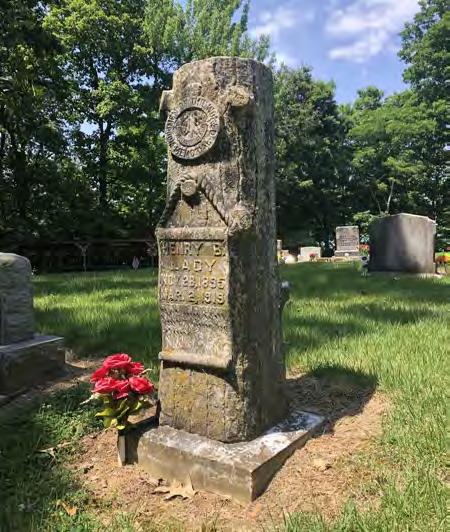
some instances, these traditional gravestones were produced at the decedent’s expense (in whole or in part), and some can be found today that bear the engraved Woodmen of the World circular seal or simply the letters “W.O.W.”
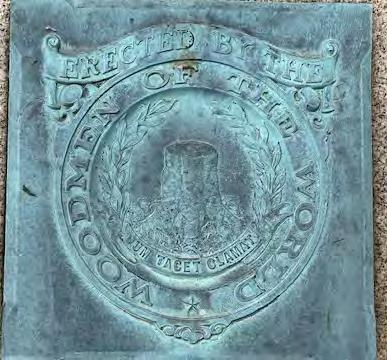

In the early part of the 20th century, Woodmen of the World had nearly 1 million members and more than 3,000 chapters across the country. At the time of its dedication in 1912, W.O.W. occupied the tallest building—at 19 stories—between Chicago and the West Coast. In the 1930s, W.O.W. had one of the most powerful radio stations in the country, and in 1949, the broadcasting arm of the company launched WOW-TV. One of the first performers on the TV station’s program was a relatively young Omaha, Nebraska, resident, comedian Johnny Carson, who hosted a daily afternoon show called The Squirrel’s Nest
The insurance company’s current 30-story headquarters—Woodmen Life Tower, completed in 1969— was the tallest edifice in Omaha until 2002. The building featured prominently in the 2002 movie About Schmidt starring Jack Nicholson as a retired Woodmen of the World insurance actuary.
I have found some of these elaborate stones at the Land Between the Lakes National Recreation Area (LBLNRA) in both the Kentucky portion and the Tennessee section. In order for the tall gravestones to be present, a cemetery obviously had to have been established prior to 1925.



Since the LBLNRA originally consisted of privately owned lands, there are approximately 270 cemeteries— mostly small family plots—scattered throughout its 170,000 acres.
Thus far, we have found three cemeteries containing at least one of the intricately detailed W.O.W. markers. My wife, Judy, and I are in the process of seeking out as many LBLNRA cemeteries as possible, but many are remote, and accessibility is challenging.
There are undoubtedly hundreds—if not thousands—of these gravestones in cemeteries scattered throughout Kentucky. I’m convinced that large cemeteries in Louisville, Lexington and other sizable cities and towns in the Commonwealth have many of the gravestones.
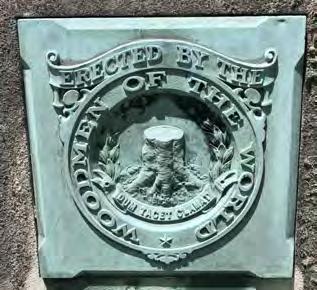 Scott County’s first permanent settlement, Big Crossing Station, was founded in 1783.
Scott County’s first permanent settlement, Big Crossing Station, was founded in 1783.
My father, Albert Caudill, was born Sep. 12, 1910, the first child of David and Polly Joseph Caudill, at Cutchin in Leslie County. His early years were spent like those of other boys at the time. He hunted, trapped and sold animal skins for ammunition and tobacco. He also spent long hours on a hillside behind a plow or wielding a hoe.
School wasn’t important to the Caudill family at the time because all children were needed at home. He finished the sixth grade before he quit and, at age 16, went to work in the mines loading coal. He once told me that he bought a suit of clothes and a pistol with his first paycheck. The latter would get him in trouble later on.
Albert came from a family of moonshiners and drinkers. It was only natural that Albert would become a drinker. His father was forced to join the army in 1915 to escape the feds, who had a warrant for his arrest for illegally producing and selling alcoholic spirits. Albert’s grandfather, Arch Joseph, also made moonshine in Leslie County. Joseph packed the alcohol in egg crates with sawdust to cushion it and carried it by mule over the mountains from Wooton’s Creek to Hazard.
Albert didn’t work weekends and would go out drinking with his friends. One night, he and a friend decided to try out their pistols. They put some holes in a car that was parked down the road, and they were caught, arrested and convicted of drunkenness and property damage. The judge gave them the choice of paying up, going to jail, or joining the United States Army. Having no money, Albert joined the army and spent most of his adult life in the military. He was sent to Fort Sill, Oklahoma, where he was a rifleman and company bugler.
During the Depression years, an Army private was paid $13 per month, a private first class $15, and a corporal $17. Albert was an expert rifleman, so he made $2 more per
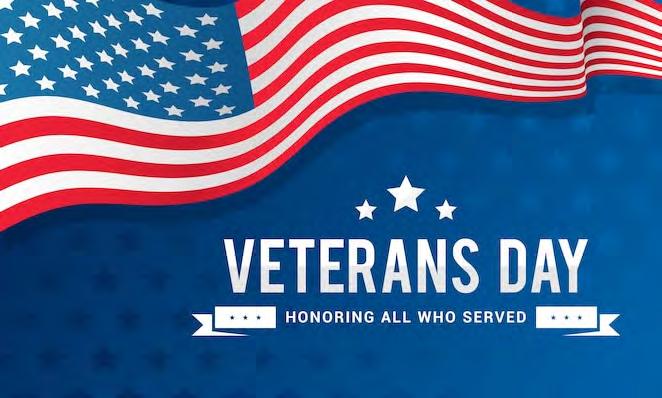

month. He needed the extra money because he met and married Lula Mae Wills from Lawton, Oklahoma, and immediately started a family. To make extra money, he gigged frogs and sold them to restaurants. Albert also worked at an ice cream shop for 50 cents per day whenever he was free.
Albert’s division left for Belfast, Northern Ireland, in early 1944. He set foot in France on Omaha Beach on June 7, at the age of 34.
When the war was over, the government instituted a point system to decide who would occupy Germany and who would go home. Taken into consideration were time in service, battles fought and medals earned. Albert had 14 years of service, five battle stars, a bronze medal, and five children. He got to go home.
After the war, Dad took our family to Rockhouse Fork of Big Willard Creek in Perry County. He attended carpentry school just outside of Hazard on the GI Bill. Later, the family moved to Wooton and lived in a nearby coal camp. When John L. Lewis took the miners out on strike, the Caudills had no reserves to live on. This forced Albert to reenlist in the Army. Three months later, he shipped out to Japan and stayed for 18 months, followed by a stint in Germany. He retired from the service in 1953.
Albert hardly ever talked about the things he had seen or done, just like others who had seen hard combat. He didn’t whine, didn’t complain, and he never felt the country owed him anything for his service. He always considered himself an ordinary soldier from Kentucky. He returned to his roots and brought his family with him to introduce them to the country, its people and, yes, its characters.
Albert’s father died in 1964, and the Daniel Boone Parkway took the old homeplace. Albert’s siblings moved to western Kentucky to work in the mines, so he and my mother decided to return to her hometown of Lawton, Oklahoma. He now rests at the Comanche County Memorial Cemetery in Lawton, Oklahoma, with a bronze marker that states: “M/Sgt. Albert Caudill, WWII, Kentucky.”
World War I began on July 28, 1914, when Gavrilo Princip assassinated Archduke Franz Ferdinand and his wife, Sophie, in Sarajevo, Bosnia-Herzegovina. The Great War, optimistically called The War to End All Wars, engulfed Europe until Nov. 11, 1918. The United States entered the war on April 6, 1917, eventually sending about 4 million troops to fight the war that cost the lives of more than 116,000 Americans in combat, infections from wounds, and the wartime epidemic of the so-called “Spanish Influenza.”
The U.S. officially designated Nov. 11 as Armistice Day to honor World War I participants. In May 1954, President Dwight Eisenhower signed a bill that changed it to Veterans Day to include veterans of all wars.
After WWI, people wanted a monument dedicated to the memory of the troops. Sculptor Ernest Moore Viquesney (born Aug. 5, 1876, in Spencer, Indiana) designed “The Spirit of the American Doughboy” in 1920. Drawing inspiration from the Statue of Liberty, he produced three variations of the design, each showing a soldier about 7 feet tall in full military gear carrying a rifle in his left hand and a hand grenade in his raised right hand. Viquesney contracted with the Friedley-Voshardt metal shop in Chicago to manufacture the statues. The Smithsonian Institution records that 159 statues were made, but today, only about 145 still exist in 39 states.
Viquesney realized that the traditional ways of producing hand-sculpted statues was too expensive and
KENTUCKY EXPLORER MAGAZINE (1986-2020) all 344 issues, over 34,000 pages now for sale in digital format. Visit kyexmag.com for ordering details. If you enjoy Kentucky history, genealogy, and much more, visit kyexmag.com (O-D)
SELF-PUBLISHING: On-Demand Book Printing, Softcover, Hardcover, and Spiral Binding, Side-Sewing for Children’s Books, Kindle Books, Typesetting, Editing, Graphic Design, Amazon Listing, BibleRebinding, etc. Contact Reformation Publishers, Inc., DBA 24-Hour Books, DBA Williams Printing Co., 14 S. Queen Street, Mt. Sterling, KY 40353, Email: rpublisher@aol.com, 1.800.765.2464, Telephone 859.520.3757, Fax 859.520.3357, Text 606.359.2064, www. reformationpublishers.com. (F-D)
time-consuming to satisfy the public eagerness to honor the dead. He created a mold and pressed pieces of copper or zinc plates before casting them with bronze. The original statue was erected in 1921, when Viquesney was living in Americus, Georgia; it was later moved to Nashville, Georgia. It cost $1,500—equivalent to $20,000 today. The sculptor also used the design to make table lamps and statuettes and produced “The Spirit of the American Navy” statue, but it was never popular.
Viquesney committed suicide on Oct. 4, 1946, in Americus and is buried with his two wives in Spencer, Indiana. The last surviving American WWI veteran, Frank Woodruff Buckles (born Wood Buckles on Feb. 1, 1901) died on Feb. 27, 2011, at 110.
Kentucky has eight doughboy statues, located in Monticello, Liberty, Winchester, Grayson, Pikeville, Jamestown, Morehead and Harlan.


WANTED TO BUY: All types of antiques and collectables. Top prices for gold, silver and costume jewelry. Scrap gold. Gold and silver coins. Wrist and pocket watches. Collections. Early post cards and fountain pens. Civil War swords and other military items. Vintage toys. Pocket knives. Lighters. Old eye glasses. Pottery and stoneware. All types of railroad items. Advertising signs. Handmade quilts. Marbles. Jars. Much much more. Complete and partial estates. Call Clarence, buyer for more than 30 years, at 606.531.0467.
(F-D)
Mom used to say Pop carried me in his arms into movie houses (babes in arms got in free in the early 1940s) until my feet almost touched the ground. This was an exaggeration, of course, but I have always loved movies, particularly from “the old days.”
Some months ago, many of you spent countless hours glued to your televisions watching the melodrama of Depp v. Heard. I confess I watched a bit.
I have seen a couple of Johnny Depp movies, including Pirates of the Caribbean. I must confess that his acting has not impressed me, and neither did his current decorations.
There are many other Kentuckyborn actors who have gained worthy national attention. In more recent years, George Clooney, Ashley Judd and Jennifer Lawrence have been the most famous “stars” to claim a Kentucky birthplace. I have seen at least some of their movies. Lawrence’s movies have grossed $6 billion, and she is the first actor born in the 1990s to have won an Oscar. Clooney has proven he can play comedy as well as drama. He is a handsome devil, isn’t he, with a sort of mischievous grin. Judd also has proven to be a rather good actress.
•
• •
Kentuckians in Hollywood go back a long way.
Born in Louisville in 1889, Tom London began his career with his birth name Leonard Clapman before Hollywood became the filmmaking capital. He had a long career from the silent film days to 1959 and appeared in around 2,000 movies and television shows—a record,
according to David Wallechinsky’s The 20th Century: History With the Boring Parts Left Out. As a kid, I must have seen London dozens of times in a “Cowboy Show” at the old Burley Theater in Shelbyville.
London appeared in some classics, including All Quiet on the Western Front (1930), The Oxbow Incident (1943) and High Noon (1952). Look for this Kentuckian, described as having “scowling, lantern-jawed features” in old westerns on TV.
Of the early Kentuckians to grace the Silver Screen, I don’t think anyone surpassed Irene Dunne (18981990). Discovered by showman Florenz Ziegfeld as a singer and dancer, Dunne became famous in comedy roles. In 1939, she co-starred with Charles Boyer in Love Affair Cary Grant, with whom she starred in My Favorite Wife (1940), claimed she had the best sense of timing of anyone in Hollywood. She received five Academy Award nominations but never received that ultimate Hollywood honor.
Henry Hull, another Louisvillian of Dunne’s generation (1890-1977), usually spoke with a noticeable Southern drawl—perhaps exaggerated. The accent fit many of the parts he played, such as his stage role in Tobacco Road (1933) and movie role in Jesse James (1939). In the film The Werewolf of London (1935), he affected something different. He turned on the drawl again as a newspaper editor in The Return of Frank James (1940) starring Henry Fonda. In perhaps his best movie, Alfred Hitchcock’s Lifeboat (1944), Hull was a millionaire hoping to survive a U-Boat attack.
Tall, dark and handsome native Louisvillian Victor Mature (1913-
1999) starred or co-starred in some great flicks. He could be menacing, as in the 1947 film noir Kiss of Death, or heroic, which he was in epic period pieces Samson and Delilah (1949) and The Robe (1953). In the latter, Richard Burton said Mature stole the scene in which he held the robe of Christ with some emotion.
Although he appeared in more than 70 films, Mature never considered himself a serious actor. He once quipped that he only acted to make money so that he could play golf.
In my youth, I had a Sunday School teacher who had known Mature when they were teenagers growing up in Louisville. He said that Mature was a nice guy. The actor served in the United States Coast Guard during World War II.
Ned Beatty (1937-2021), who grew up in St. Matthews, had a long career as the ultimate character actor, appearing in six movies with Burt Reynolds and four movies with Christopher Reeve, along with many others. He was given the distinction as “the busiest actor in Hollywood,” appearing in more than 150 movies.
If you remember Deliverance, you cannot forget Beatty’s performance. He received his only Oscar nomination for best supporting actor in 1976 for Network. In many ways, he was an actor’s actor, having performed on stage both before and after his movie career. He could well be the best and most versatile actor of our native Kentuckians.
Another character actor, James Best (1926-2015), a native of Powderly in Muhlenberg County, was orphaned at an early age and grew up in Corydon, Indiana. He played dozens of roles, including the
bumbling Sheriff Rosco P. Coltrane on the Dukes of Hazzard TV comedy series and, with his distinctive accent, is easily recognizable in his roles in westerns.
Warren Oates (1928-1982), also born in Muhlenberg County, appeared in dozens of TV westerns before graduating to movies, often directed by Sam Peckinpah. In keeping with his sense of humor, he once said, “I started out as playing the third bad guy on a horse and worked my way up to number one bad guy.”
Oates was always fun to watch no matter what role he played. He died all too soon at age 53.
• • •
Much has been written about West Irvine native Harry Dean Stanton (1926-2017), who was in numerous TV dramas, including eight appearances on Gunsmoke. His roles included Paul in the controversial movie The Last Temptation of Christ (1988) and supporting parts in other famous films such as Cool Hand Luke (1967), science fiction thriller Alien (1979) and The Green Mile (1999), one of my all-time favorites.
Lexington began a Harry Dean Stanton Fest at the Kentucky Theatre in 2011 and premiered Harry Dean Stanton: Crossing Mulholland, written, produced and directed by Tom Thurman, a producer-writer for KET. Thurman interviewed Stanton numerous times. “Harry Dean rarely answered a single question in a direct manner … I used his evasiveness as a structural device and didn’t see it as an obstacle,” Thurman said. Stanton appeared in five of his documentaries. “He never let me down or disappointed me. He might not have bothered to wash or comb his hair and even change his clothes from the night before, but he always showed up and gave me something special on camera.” The son of Arnold Thurman, who was my assistant football coach at Shelby County High School back in the early 1960s, Tom, who proudly claims Christianburg as his birthplace, has become a fine documentarian.
Since 1992, Thurman has produced and directed more than 30 TV biographies, beginning with
Warren Oates: Across the Border, and including such personalities as Harry Crews, Hunter S. Thompson, Sam Peckinpah, John Wayne, Nick Nolte and Robert Penn Warren. Thurman also has contributed to the Kentucky Muse series.
Thurman added that Lexington native Michael Shannon (born in 1974) is among a group of established Hollywood stars, having received two Academy Award nominations. “He is absolutely one of our best,” Thurman said.
• • •
Most every week, I watch The Video Vault on KET. Hosted by Morehead State University Professor Jeffrey Hill, the series features individuals with a Kentucky connection. The eighth season of the program airs on Sunday at 8 p.m. I love Hill’s closing line for each episode: “Watch more movies.” Jeffrey, don’t forget the hat.
Some months ago, Hill featured Louisville-born Billy Gilbert (18941971), a comedian with a storied career. Whenever I feel down in the dumps, I watch the old Laurel and Hardy comedy The Music Box (1932), in which Gilbert played an eternally flustered professor. Hill often highlights the work of native Kentuckians who worked behind the cameras.
Hill has spotlighted the career of Charles Middleton, a native of Elizabethtown who appeared in dozens of roles, ranging from Abraham Lincoln to Ming the Merciless in the Flash Gordon serials in a career lasting from 1920-1949. I recall the latter as being shown as short films at movie theaters and later on TV. With his ominous baritone voice and imposing tall stature, he made a perfect villain. The Flying Deuces, released in 1939, is a classic Laurel and Hardy flick with Middleton as a French Foreign Legion officer.
Other important Kentucky natives have had successful entertainment careers. William Conrad (1920-1994) was the radio voice of Matt Dillon and starred in the TV series Jake and the Fatman. This native Louisvillian had a career that spanned five decades. And who can forget Tom
Ewell (1909-1994), the pride of Owensboro, who muddled around in The Seven Year Itch (1955) with actress Marilyn Monroe?
Even Irvin S. Cobb (1876-1944), a native of Paducah famous for his newspaper, magazine and book authorship, appeared in movies. His most famous role was opposite Will Rogers in Steamboat Round the Bend (1935). He also wrote movie scripts, with a character named Judge Priest as the subject of two movies. Yours truly wrote a biography of the multitalented Kentuckian titled Irvin S. Cobb: The Rise and Fall of an American Humorist.
I think the best acting talent Kentucky can claim is Patricia Neal (1926-2010), the sultry-voiced actress born in Packard, a Whitley County coal camp. Neal (Kentucky Monthly, March 2001, page 10) starred in numerous Hollywood blockbusters, including The Fountainhead (1949), The Day the Earth Stood Still (1951), A Face in the Crowd (released in 1957 with a menacing Andy Griffith), and Hud (1963), for which she won an Academy Award. She played Olivia Walton in the TV drama The Homecoming: A Christmas Story (1971), which spawned the long-running series The Waltons
The drama Neal endured while married to British writer Roald Dahl was as compelling as her movies. One of their children died early in life. Neal suffered several strokes and had a long recovery period. She relearned to walk and talk, but her speech was slowed. Dahl stayed with her throughout the tragedies, but they divorced after 30 years of marriage.
Neal returned to the United States and continued her career. She played her last movie role only a year before her death in 2010. In her 1988 autobiography, As I Am, she claimed, “A strong positive mental attitude will create more miracles than any wonder drug.”
As you can tell, I am a movie fan, particularly of the Golden Age of Movies.
Who is your favorite Kentuckyborn actor or actress?
Readers may contact Bill Ellis at editor@kentuckymonthly.com
My wife and I are nearing the fourdecade marriage mark, and, probably like some of you, our home has become a gathering place for an eclectic assortment of furnishings, several of which arrived by way of deceased relatives and friends. A frayed cane rocking chair. A chipped and cracked century-old cedar chest. Aunt Katy’s bookcase. A rough-hewn cabinet hammered together by a favorite uncle, that, at some point, was converted into a sparse bookshelf. Most remain practical, useful items. A few are beyond dayto-day use. A couple are heirloom quality. Several are yard-sale worthy.
One such passed-around piece currently in our possession is a Sellers kitchen cabinet, the style of which I only recently learned is generally referred to as a “Hoosier cabinet.” Apparently, 100 years ago, they were wildly popular. It remains usable, but it is far from pristine. I am certain of its manufacturer only because the metal nameplate survived years of use, abuse and neglect, while also having endured numerous moves. It hasn’t been in a kitchen since the Nixon administration, having served various purposes since—from being stuffed with children’s grade-school art projects to, most recently, residing in my wife’s home office as storage for reams of wool, roving, baskets, boxes, needles, cables, scissors, stitch markers, a lazy kate, spools, bobbins, a knitty knotty and other assorted spinning and knitting goodies.

It recently has found a new, and likely permanent, home.
“What do you think we should do with the cabinet?” my wife asked after an office upgrade, including new
shelving that provides ample space for the spinning and knitting tools, toys and supplies.
“I think I have a use for it.”
“Where?”
“In my office.”
“Your office?!”
The response was understandable. Most days my “office” resembles a used tackle shop liberally strewn with rods, reels, line, lures, flies, flytying makings, waders, boots, boxes, more reels, more line … It’s an ugly image that is multiplied during hunting season.
“What are you going to put in it?”
A bit of online research revealed that Sellers was an Elwood, Indianabased company and launched what became known as a Hoosier-style kitchen cabinet in 1898. The idea was simple: a multi-tool for the busy cook. A kitchen workstation to serve
multiple needs (workspace/ counter, storage, flour sifter, shelving and more, depending on the style and size of the cabinet). They were an immediate hit. Millions were sold.
I’ve no idea how one that now resides in my office came into my mother’s possession. I assumed it belonged to her mother.
I moved the cabinet to my office, stationed it against a brick wall, and loaded it up.
“It looks good in here,” my wife said, inspecting the nearly century-old cabinet that looks every day of its age. “What’d you put in it?”
I opened the doors to reveal a ridiculous amount of neatly stacked fly-fishing gear. I pointed to a bottom shelf. “I put the camp cooking stuff down here,” I said a bit too proudly. “Just like in the kitchen!”
• • •
For many Kentucky hunters, November means deer season. Archery whitetail season has been open since Sept. 3, and crossbow season since Sept. 17, but the modern gun hunt, which is when most deer hunters are in the woods and most deer are tagged, runs Nov. 12-27 in all zones. Bag limits and zone details are at fw.ky.gov
While deer hunters will be out in force, November also affords waterfowl hunters their first shot of the season. New this year: Young hunters and military will get the first shot.
For the 2022-2023 season, the Department of Fish and Wildlife Resources is offering two one-day youth/military waterfowl hunts. Dates are Nov. 19 and Feb. 11 for youth hunters and Nov. 20 and Feb.
12 for military. The youth and military hunts will be statewide. Regular-season state and federal license requirements and bag limits will apply.
Young hunters, according to the state game agency, must be “under the age of 16” on the day of the hunt. The two-day military hunts are open for “military on active duty and honorably discharged veterans of the U.S. Armed Forces only. Per federal rule, National Guard members and reservists are only eligible if they are on active duty.”
Kentucky’s duck, coot and merganser regular season opens Thanksgiving Day (Nov. 24) through Nov. 27. Duck/coot/merganser season re-opens Dec. 7 and runs through Jan. 31.
Canada goose, white-fronted goose, snow goose and brant season opens Thanksgiving Day and will run through Feb. 15.
The Thanksgiving weekend waterfowl opener is popular but not always productive. Duck and goose hunting is largely weather driven, and birds are sometimes scarce during the four-day opener.
State game officials conduct waterfowl counts throughout the season. These surveys provide a pretty good snapshot of duck and goose population across the state. Counts typically begin in mid- to late November but are weather dependent. When available, the Waterfowl Reports and Surveys will be posted at https://fw.ky.gov/Hunt/ Pages/Waterfowl-Reports-andSurveys.aspx
For other information, including bag limits, license requirements and a list of public waterfowl hunting spots, go to fw.ky.gov or contact the Department of Fish and Wildlife Resources at 1.800.858.1549.
Readers may contact Gary Garth at editor@kentuckymonthly.com






McNeil’s Solo Art Exhibit, Artists Attic, Lexington,
Louisville Marathon, Half Marathon and 10K, Beckley Creek Park, Louisville, 224.757.5425
downtown
Center for
Asbury University, Wilmore, through Nov. 12, 859.858.3511

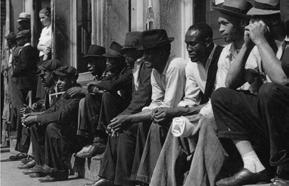
“Pears on a Glass Table,” from Kasandra McNeil’s Solo Art Exhibit

Goo Goo Dolls in Concert, Louisville Palace,
Bela Fleck in Concert, Bluegrass Hall of Fame and Museum, Owensboro, 270.926.7891
Bourbon & Barbeque Louisville, Waterfront Park, through Nov. 12, 502.574.3768
Family Farm Day, Homeplace on Green River, Campbellsville, 270.789.0006
Throo the Zoo 5K, Louisville Zoo, 502.459.2181
Home for the Holidays Barn Lot Theater, Edmonton, 270.432.2276
Texas Tenors in Concert, SKyPAC, Bowling Green, 270.904.1880
Concert, presented by the LYO, Kentucky Center for the
Louisville,
through Nov.
Jingle Bell Concert, Kentucky Center for the Arts, Louisville, 502.566.5111




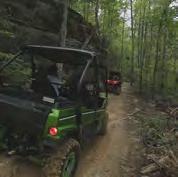






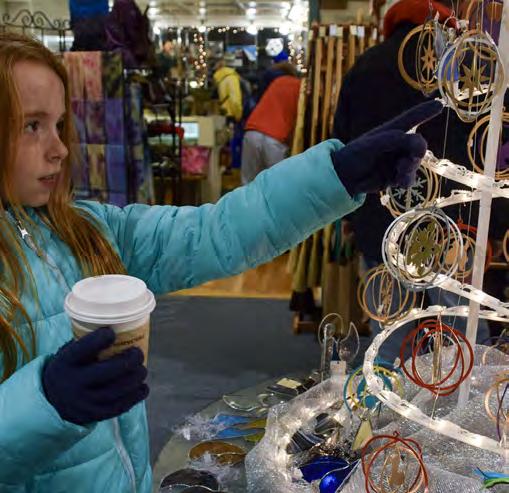


Our dog, Toby, has died. Don’t worry; this will not be one of those sad dead-dog stories. I shed enough tears for all of us, so I won’t put you through that torture.
When I posted to social media that Toby had passed, I was flooded with words of comfort—most of which included something about pets being like our children, our fur babies. They included images of rainbow bridges and frolicking happiness. While the messages were kind, they missed capturing who Toby was. He was an 11-pound cutie to most, but to me, Toby was a wise, elderly fellow disguised as a Yorkshire TerrierDachshund mix.
Once, when he accompanied me to a brief meeting at the Headley-Whitney Museum near Lexington, a woman, after watching him frolic on the long, flat lawn, asked me in the voice of Mrs. Thurston Howell III, “What do you know of your dog’s breeding?”

“Not much,” I said. “I wasn’t there.”
The people at L.I.F.E. House for Animals, a noneuthanizing shelter in Frankfort, said that Toby was a “dorkie.”
“Oh, no,” the Mrs. Howell soundalike said. “I am sure Toby is a long-haired dachshund of the rarest kind.”
I claimed Toby was named after Tobias Wolff, the author of This Boy’s Life among other books, but it’s the name he had when we rescued him.
My youngest daughter, Sydney, discovered Toby. She came home from volunteering at L.I.F.E. House insisting we adopt “this special dog.”
STEPHEN M. VEST
adapted to him. He was at the center of our family from Day 1, the first to pose for family photos. Toby loved his sweaters. He was ready for work, strategically positioning himself to watch over whoever was in the office on a particular day.
In Silas House’s latest book, Lark Ascending, the title character is joined on his journey to Glendalough by Seamus the beagle, who was named after the Nobel Prizewinning poet Seamus Heaney Not easy to reach, Glendalough represents a safe place in a glacial valley in Ireland’s Wicklow Mountains. I believe that, like Seamus, Toby would have gone anywhere with us.
As my cousin George Graham Vest, who is credited with coining the phrase “Dog is man’s best friend,” wrote, “He will sleep on the cold ground, where the wintry winds blow, and the snow drives fiercely, if only he may be near his master’s side.”
In Bowling Green one weekend, Sydney, as a college freshman, went alone into a Dollar General with tinted doors. Toby watched her go into the store from the car, but when the doors closed and he could no longer see her, without hesitation, he dove out of the car window, leaping three to four feet to join her inside.
Toby loved visiting nursing homes. He liked older people and children.
My home and office are maybe a quarter-mile apart. Between the two are a dozen houses and Highway 420, a winding north-south road between U.S. 127 and Frankfort’s East-West Connector. It follows one of the many creeks that feed into the Kentucky River south of Frankfort. Toby and I used to walk to work all the time, or at least on days we didn’t need the car. He would stand ready to put on his sweater and wait at the basement door so he wouldn’t be left behind.
+ Editor-in-ChiefThe problem was that he was a part of a set with his sister, Macy, with whom—we were told—he had spent his entire life. We went to see Toby but second-guessed our ability to take on two dogs. We spent the weekend mulling the idea before returning to L.I.F.E. House to adopt the pair, only to find that their previous owners had returned over the weekend to retrieve Macy, leaving Toby there alone. That was a decade ago.
I would say Toby adjusted quickly, but honestly, we
Our two-story house is situated over a two-car garage and half-basement. A 6-foot privacy fence surrounds the backyard. On days when we left Toby at home, which was infrequent, he would watch from the deck a few feet above the privacy fence as we drove away. We don’t know how, but at least a dozen times, when we’d gone to work without Toby, he joined us there within an hour. At least once, when he discovered we weren’t at work, he safely returned home.

At the heart of America’s inland waterways, you’ll find a sophisticated rivertown that inspires. Paducah, Kentucky, is a confluence of cultural heritage and creativity where art goes beyond something to appreciate – it’s a way of life.


A designated UNESCO Creative City, Paducah is gaining acclaim as a destination for those who crave rich, authentic cultural experiences!
Immerse yourself in the artistry and technique of masterpieces from around the globe at the National Quilt Museum. Plan your experience at Paducah.travel 1-800-PADUCAH
